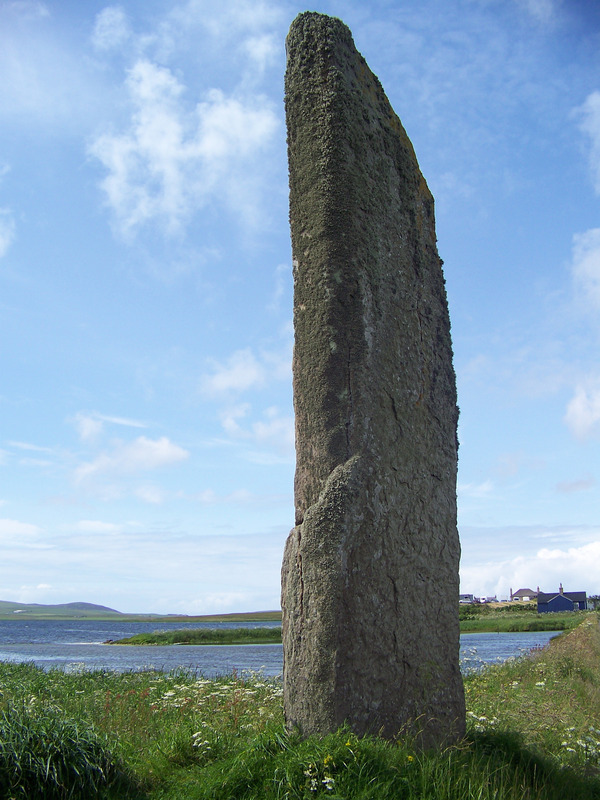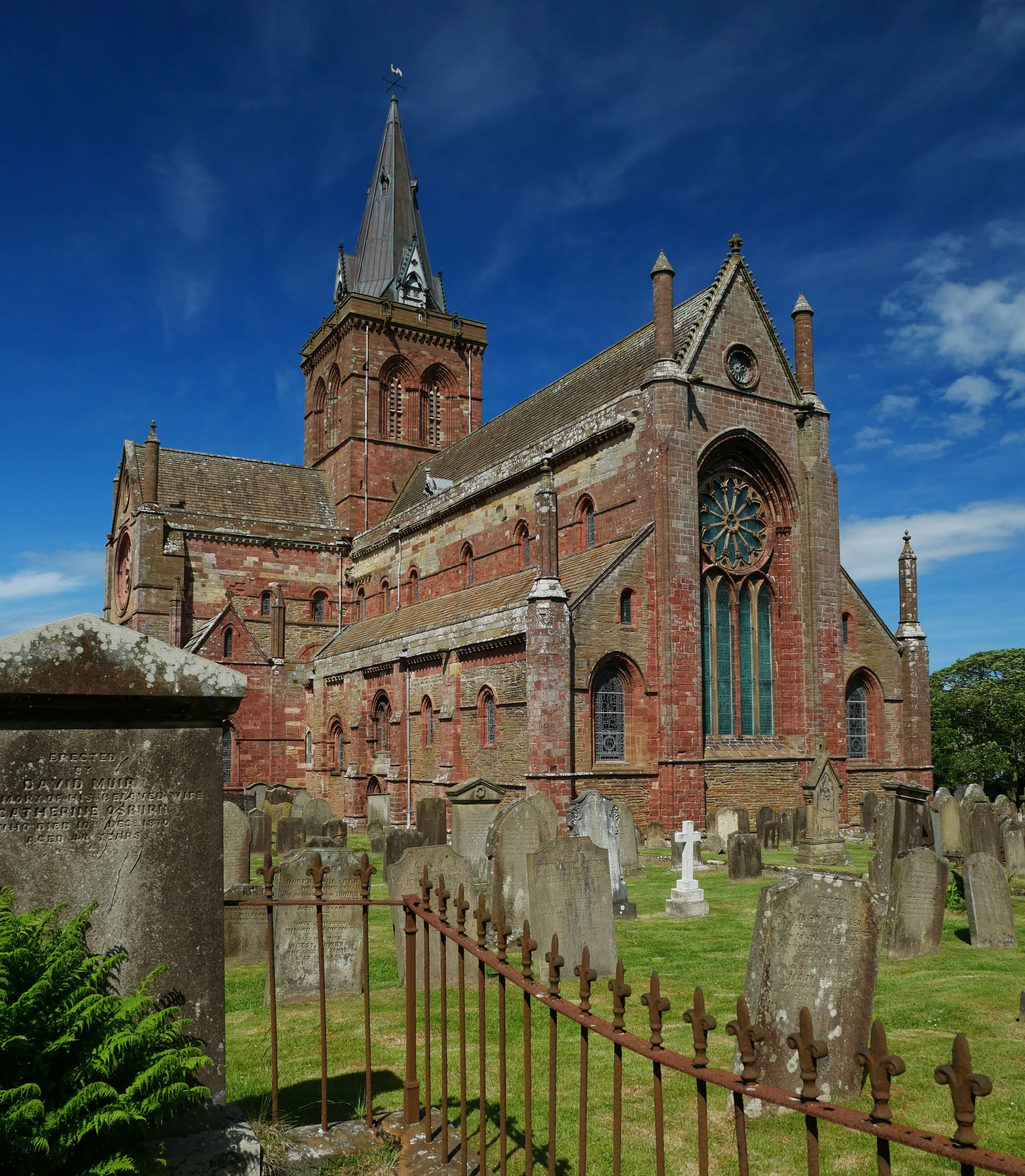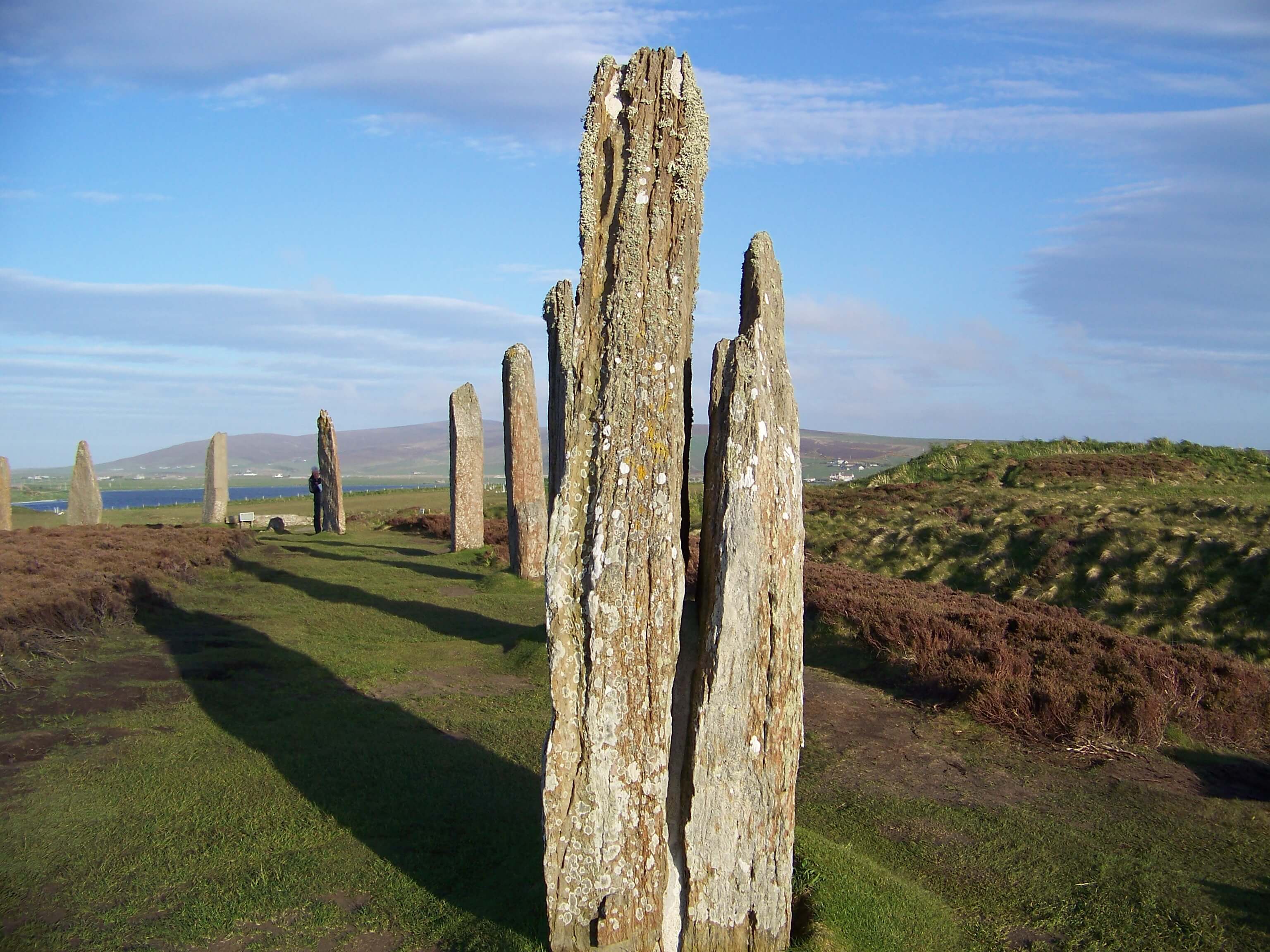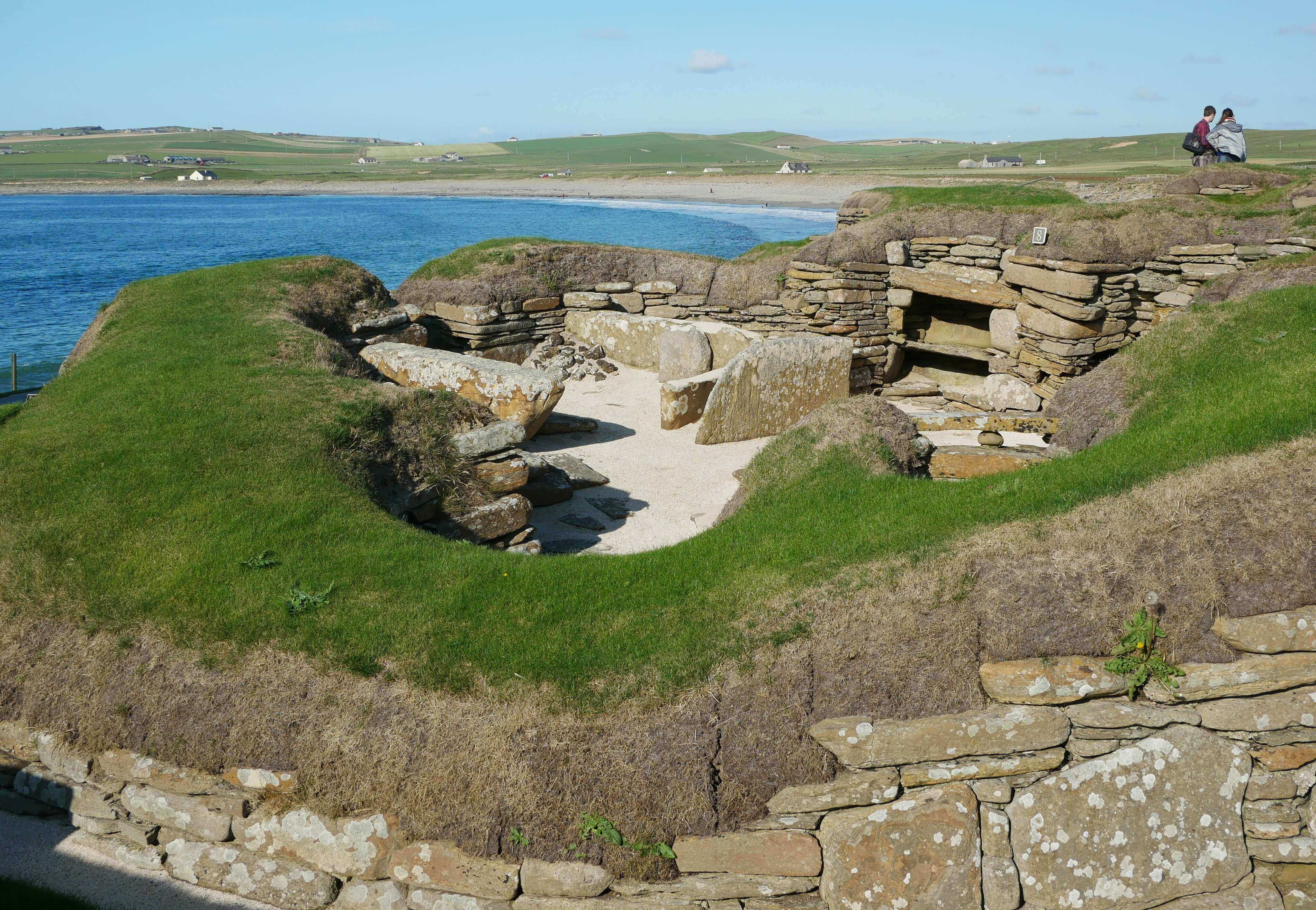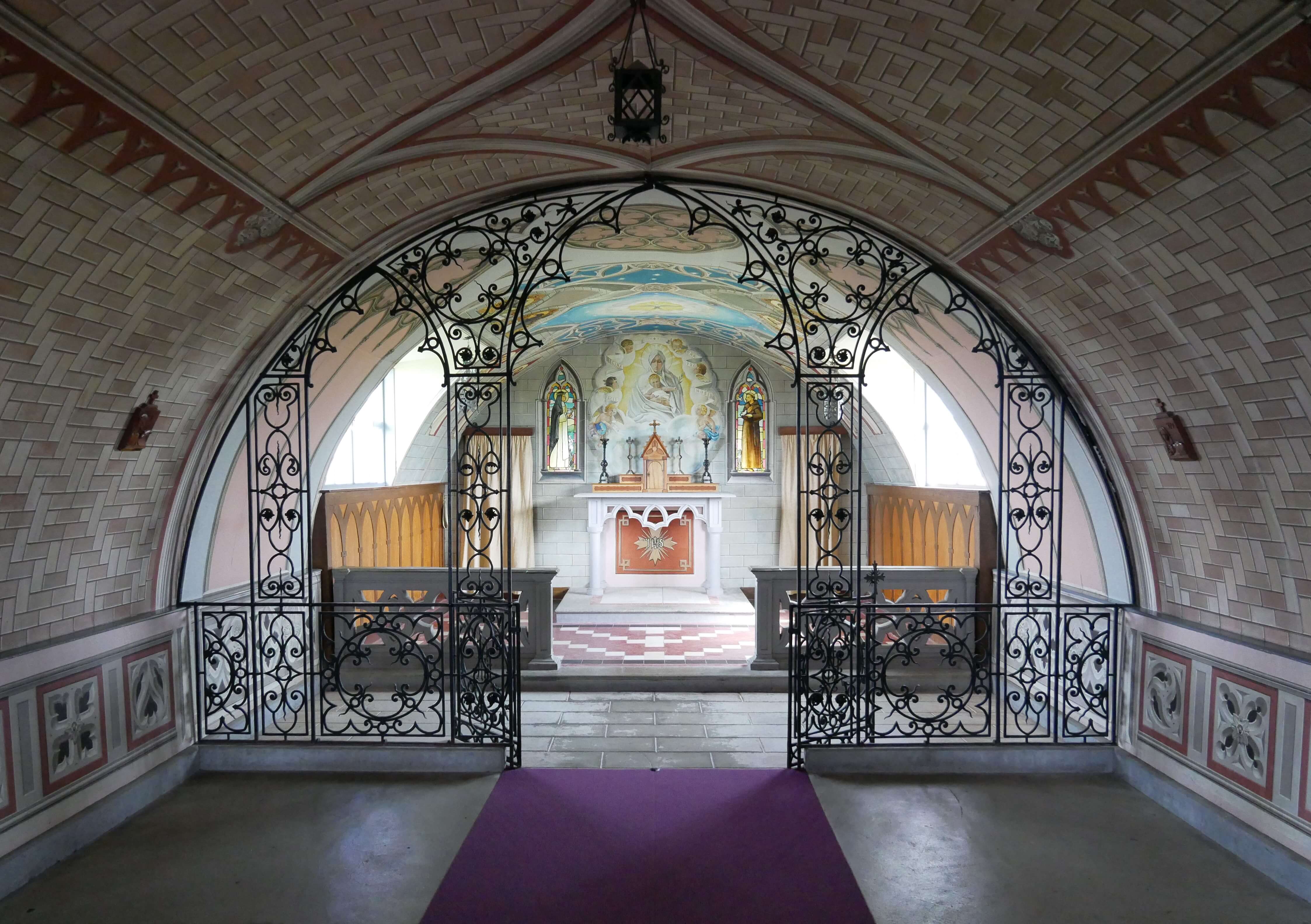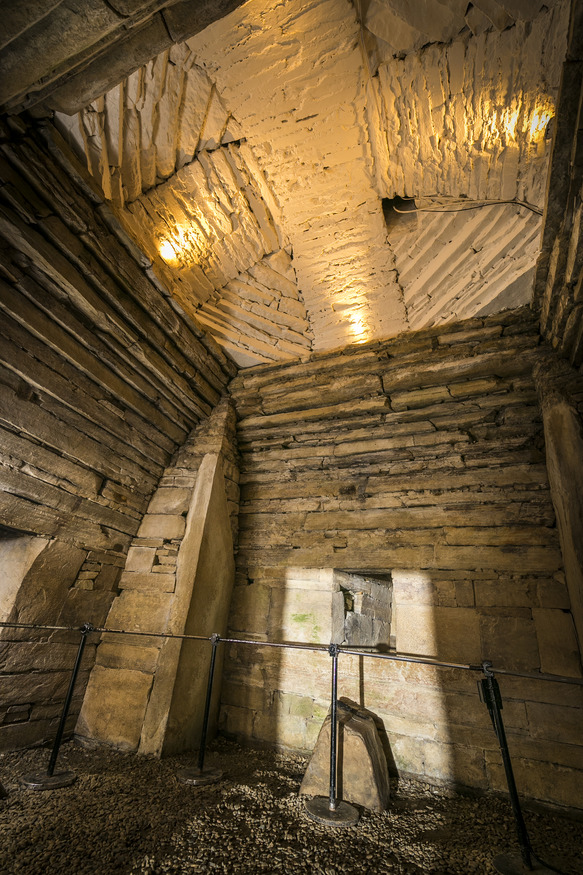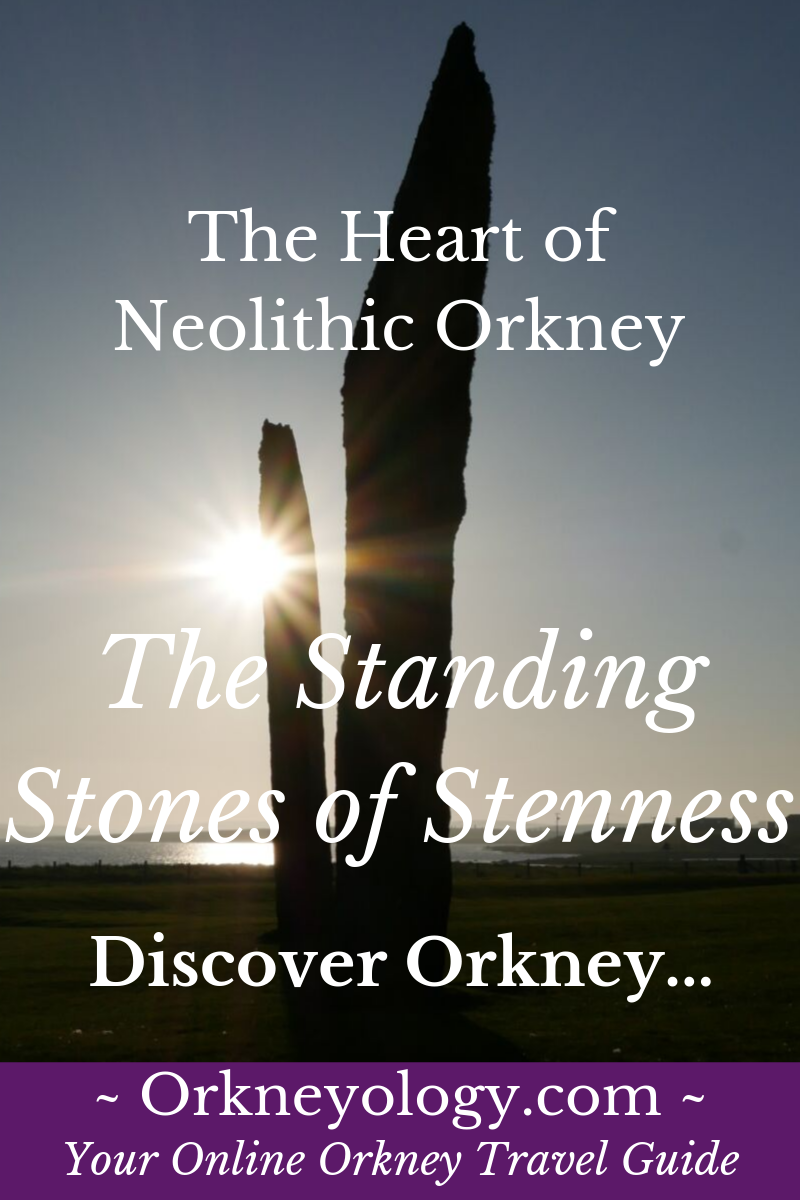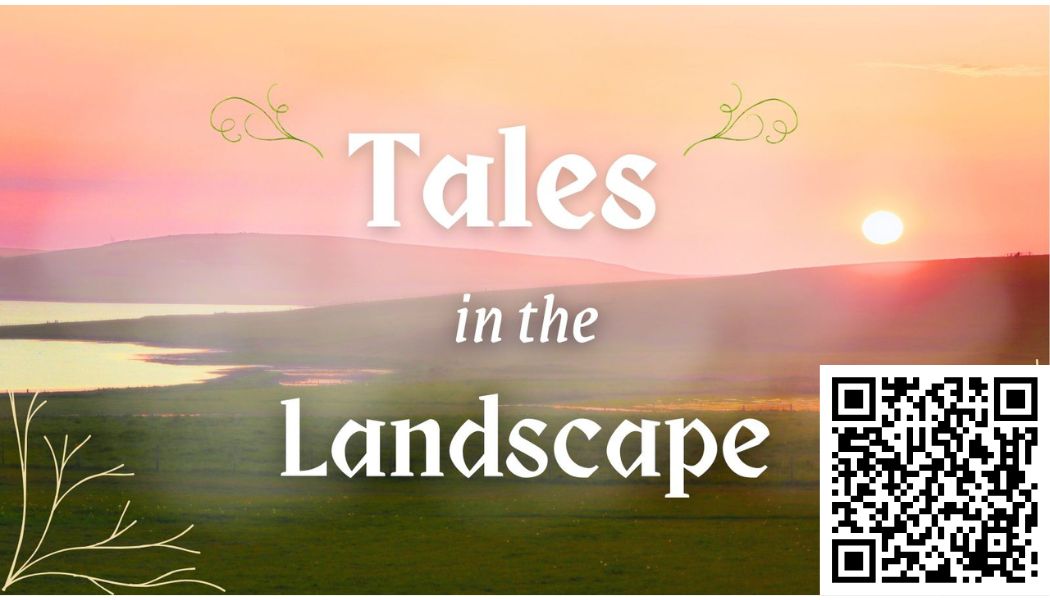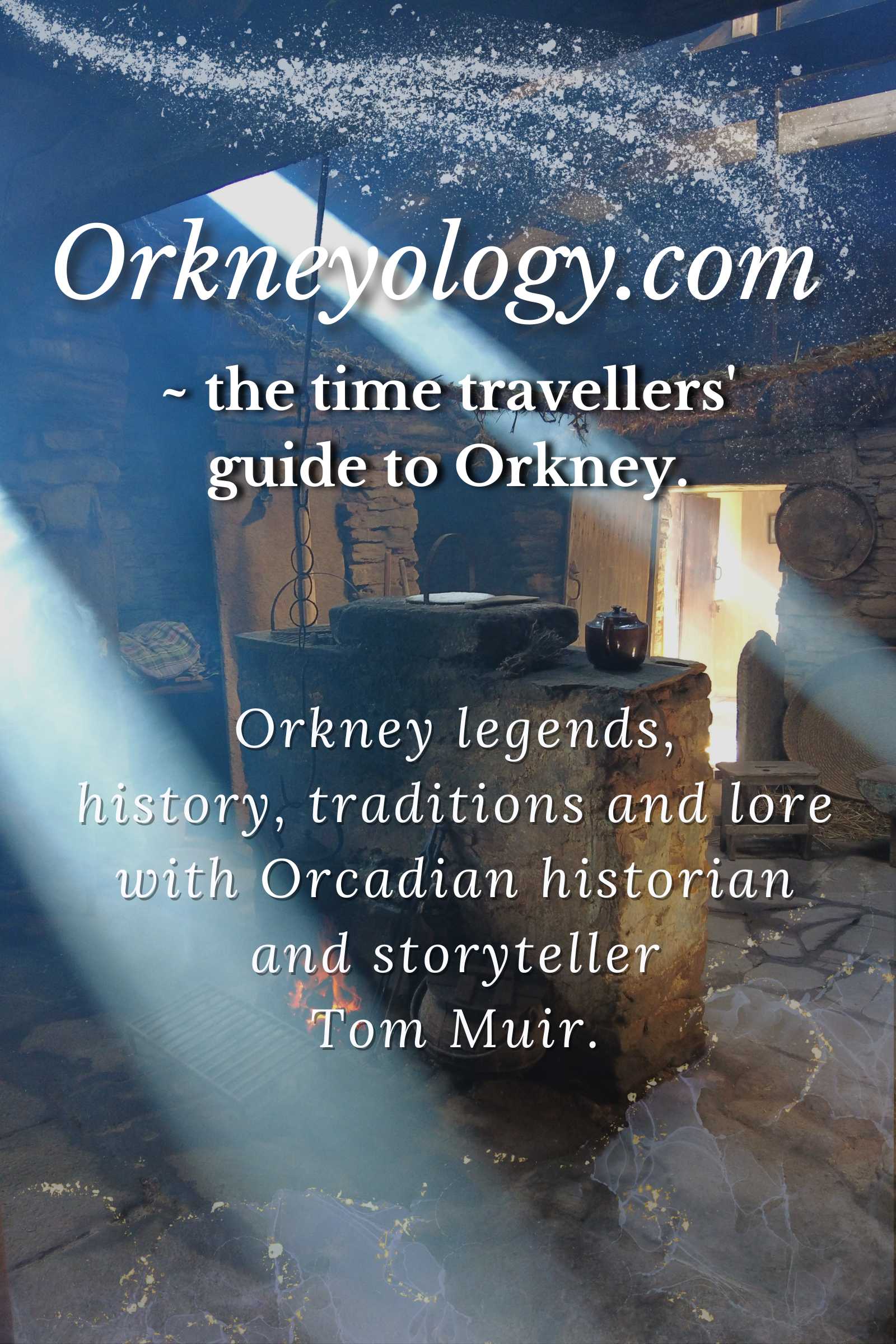Orkney's Stones of Stenness
Yes, they are older than Stonehenge!
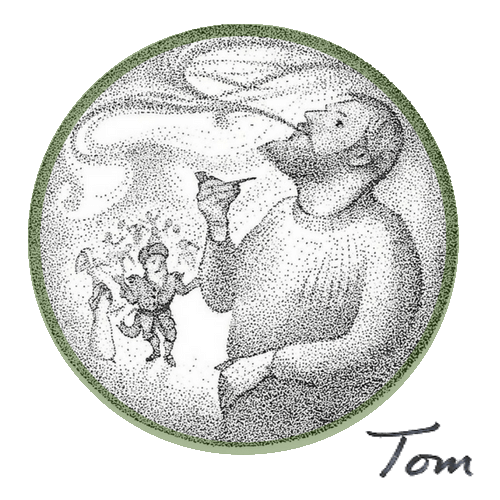
When I was a boy, aged nine or ten, my family took a twice annual car journey from my home at Valdigar, Tankerness, to visit my namesake uncle at Easthouse, Sandwick.
This trans-Orkney trek meant driving past imposing and impressive Neolithic monuments. The majestic green mound of Maeshowe Tomb and the mysterious stone circles of the Stones of Stenness and Ring of Brodgar fascinated me.
But the Watch Stone standing beside the road at the bridge between the Stenness and Harray Lochs scared the crap out of me.
The stone was so tall and threatening, looming over the road we drove along. What if it should choose that moment in time to fall, just as I was underneath it?
I had an over-active imagination in those long, hot summers of my childhood.
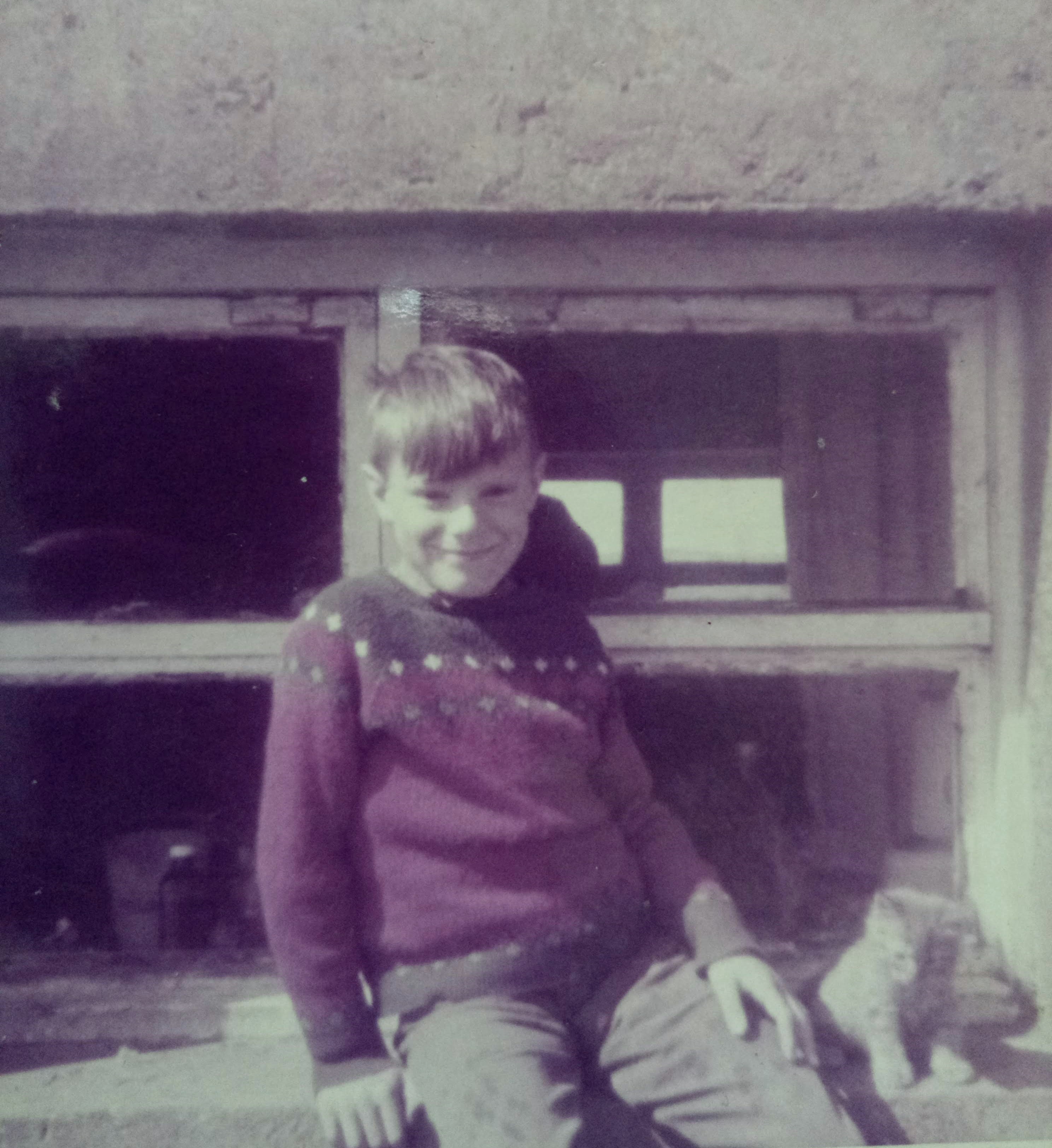
What's on this page?
Archaeology at the Stones of Stenness
What is that thing?
It was during one of these summer journeys that I first saw a fantastic creature, though I have since seen many. I thought they were found only in myths and legends, but I caught a fleeting glimpse of a group of them. I saw them just as plainly as I can see this keyboard.
What was this exotic creature? A unicorn? A centaur? A dragon?
No. It was ...
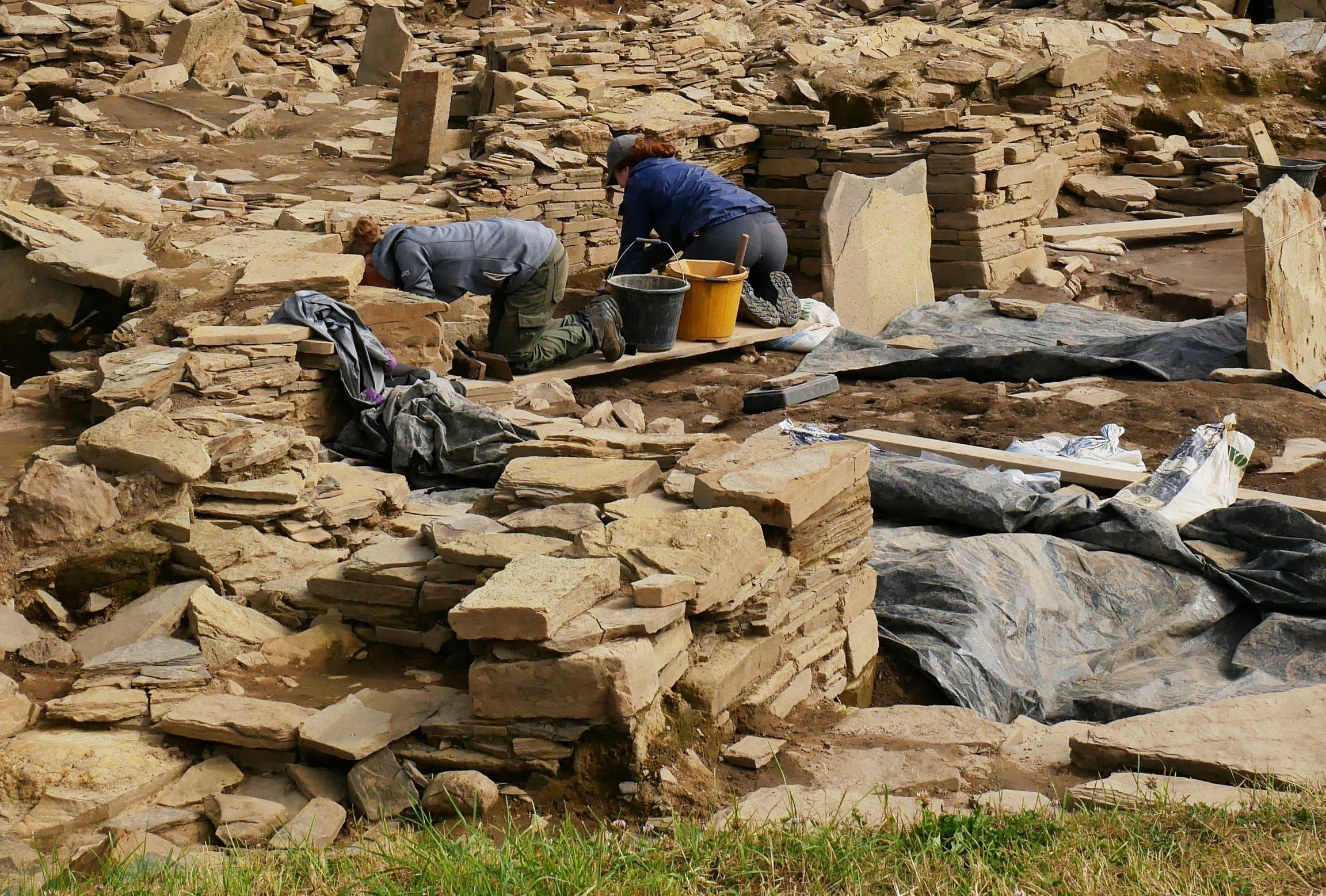
... an Archaeologist!
I'd never seen archaeologists before.
I thought they were only found in pharaohs' tombs in Egypt or Greek temples in Athens, not in Orkney. But there they were, bums up, trowling away. Little did I know that less than ten years later I'd be doing the same thing.
But that’s another story.
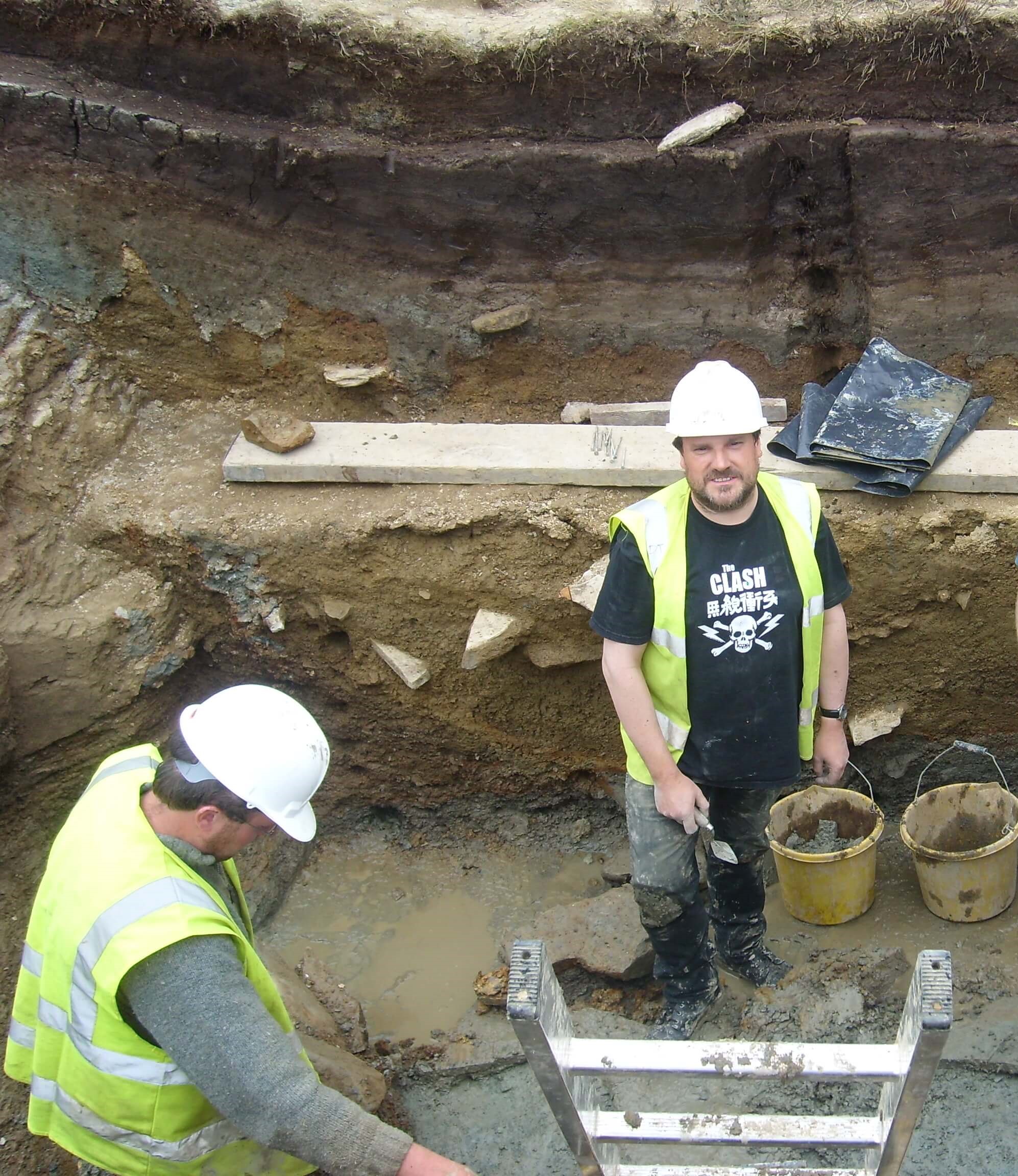
So, why were these archaeologists there?
The capping slab of a ‘dolmen’ inside the Stones of Stenness had been pulled off in 1972. Quite likely it was by a tractor or car.
This act of wanton vandalism was actually greeted with approval among antiquarians in Orkney.
The dolmen that was destroyed had been fabricated in 1907. By the early 1970s it had been recognised as a fake.
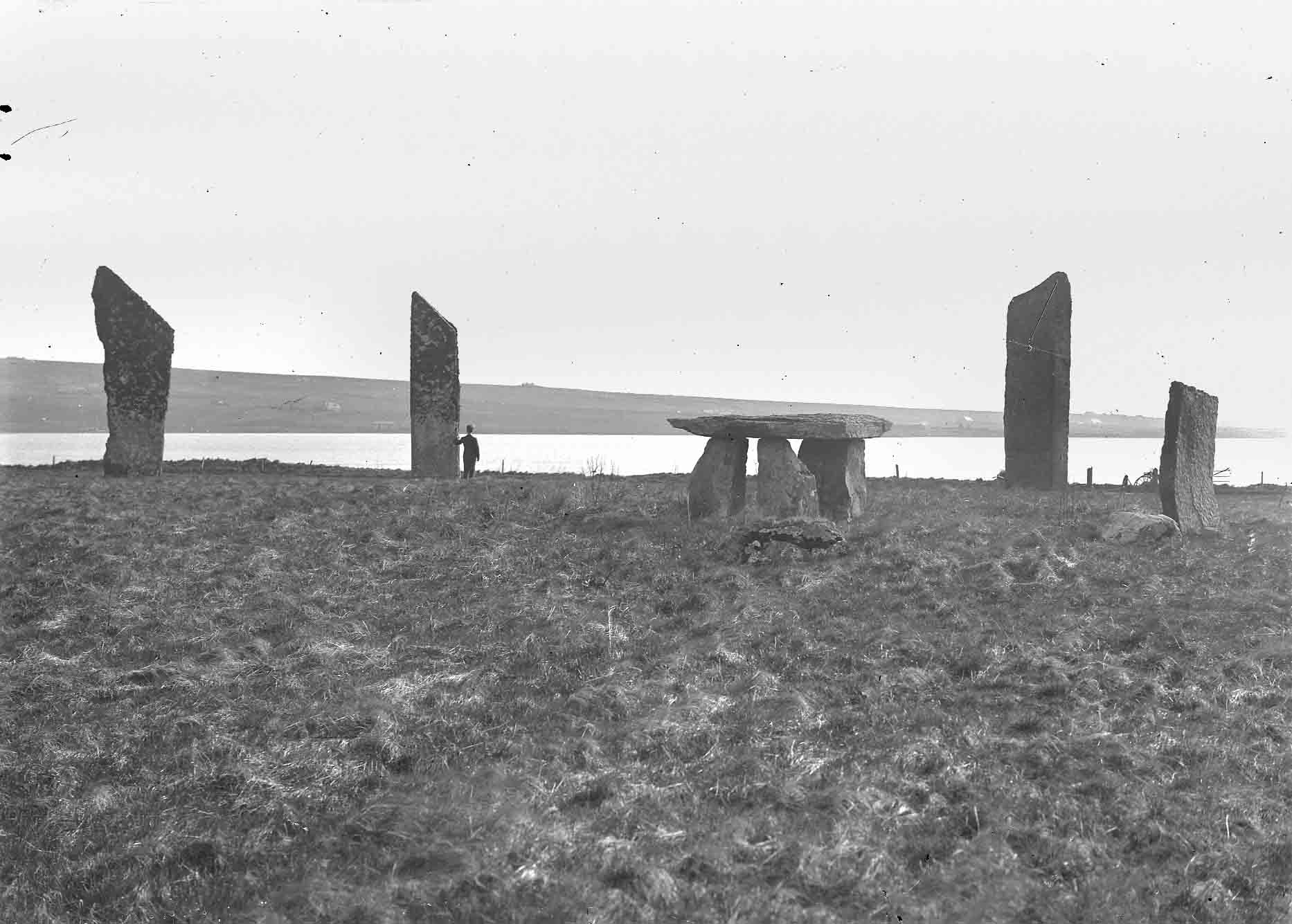 Tom Kent photo courtesy of Orkney Library & Archive
Tom Kent photo courtesy of Orkney Library & ArchiveThe fake dolmen's destruction led to an excavation of the site from 1973-4 by my late friend, Graham Ritchie.
Graham and his wife, Anna, contributed a lot to our understanding of Orkney’s archaeology.
Look for the Ritchies'
'Ancient Monuments of Orkney'
on Abe Books
Free Postage to the USA at AbeBooks
Free Shipping to Canada at AbeBooks
Free Postage to the UK at AbeBooks
Excavating the Stones of Stenness
The Stones of Stenness excavation was quite extensive.
The archaeologists found that there was one entrance through the ditch, or ‘henge’, at the north side of the circle.
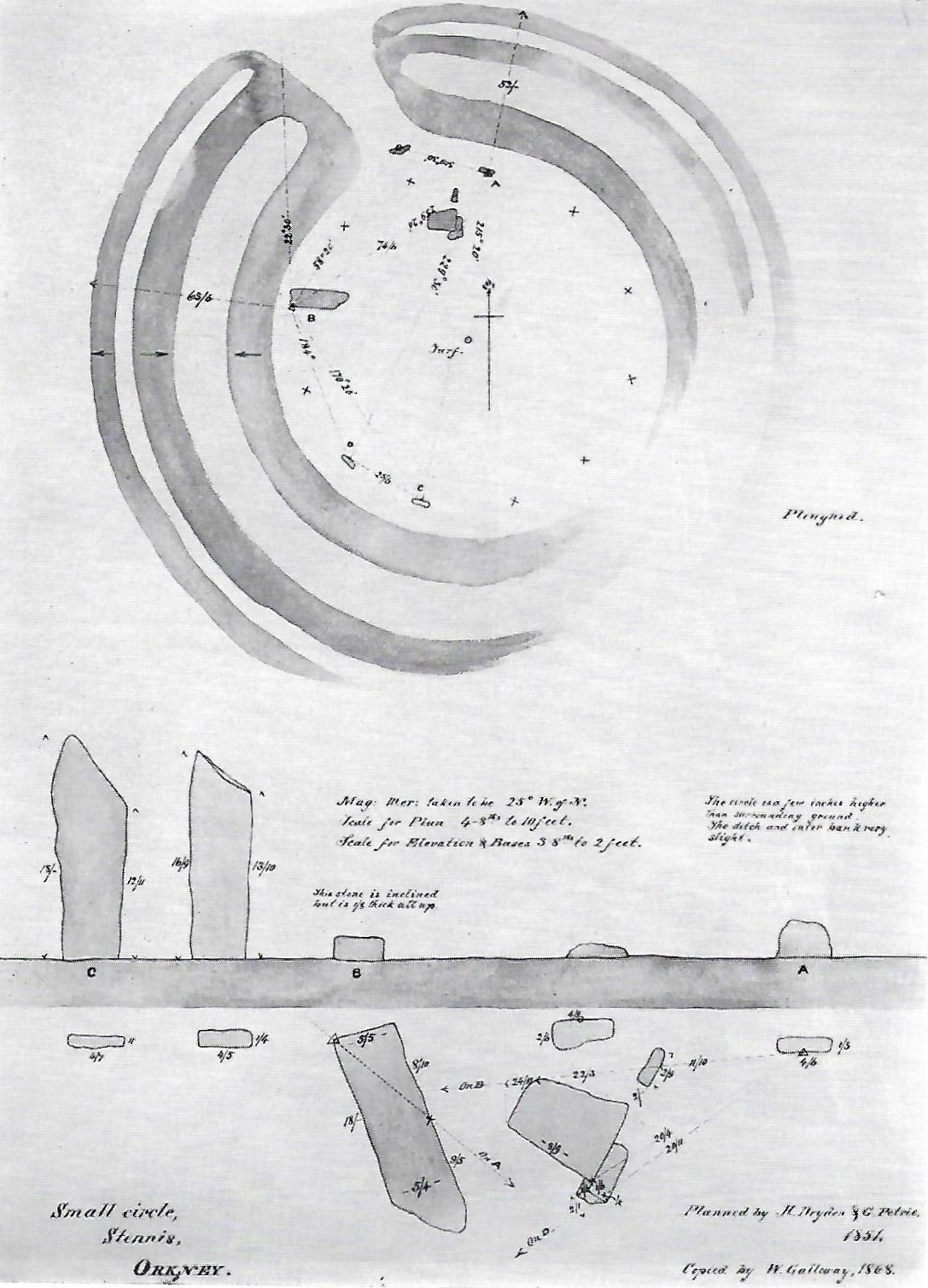 H Dryden and G Petrie, 1851
H Dryden and G Petrie, 1851This entrance faces the Neolithic settlement of Barnhouse, which was discovered by Colin Richards in 1985.
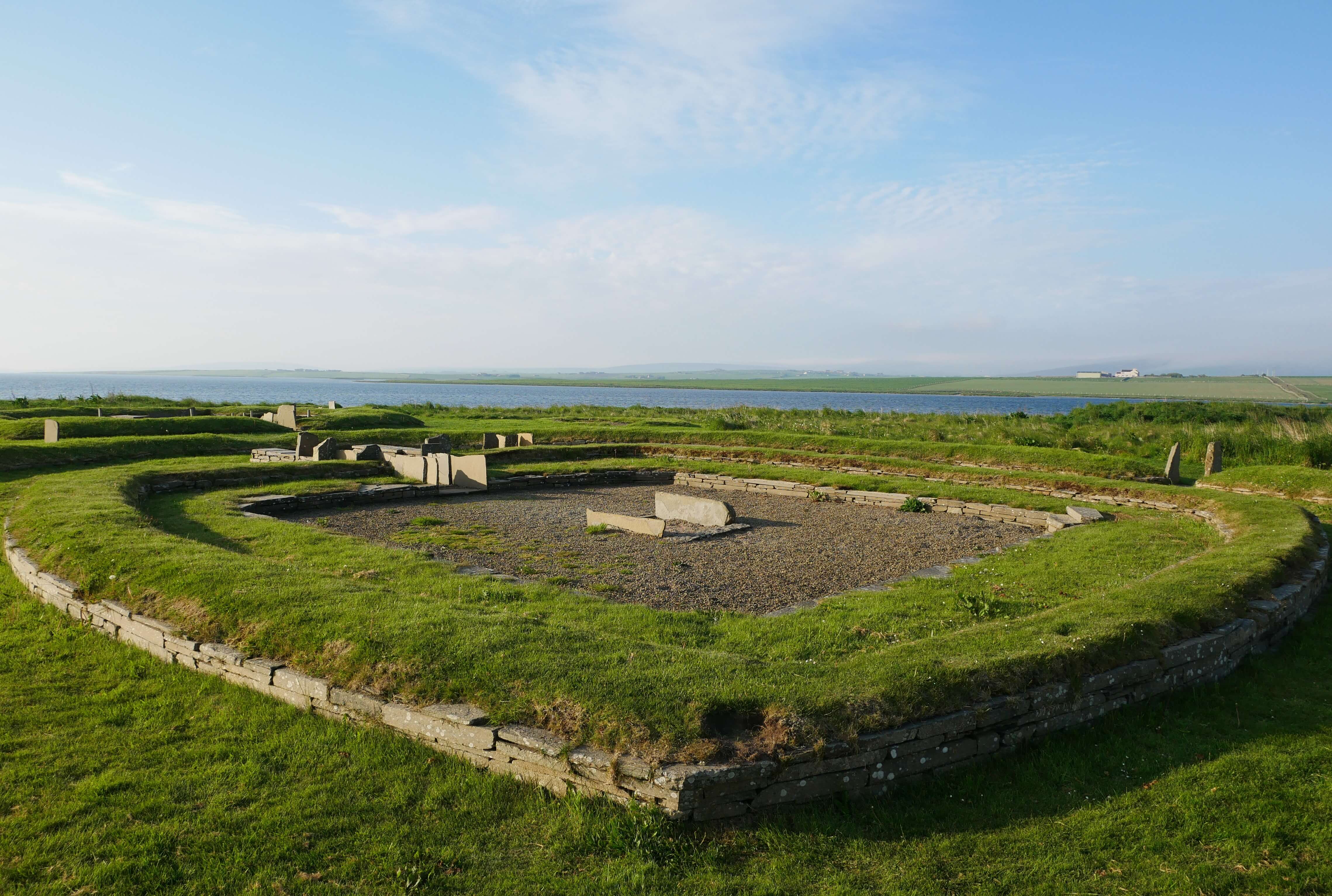
The ditch around the Stones of Stenness is 6 ½ feet deep (2 meters) and 144 feet (44 meters) in diameter. The ditch was lower than the water table, so it would have been constantly filled with water.
This ring of water may have been significant to the Neolithic people - perhaps a sacred separation of the ritual site from the outside world.
Water was seen as a gateway to the spirit world in later societies. There is no reason to think that it was any different in the Neolithic.
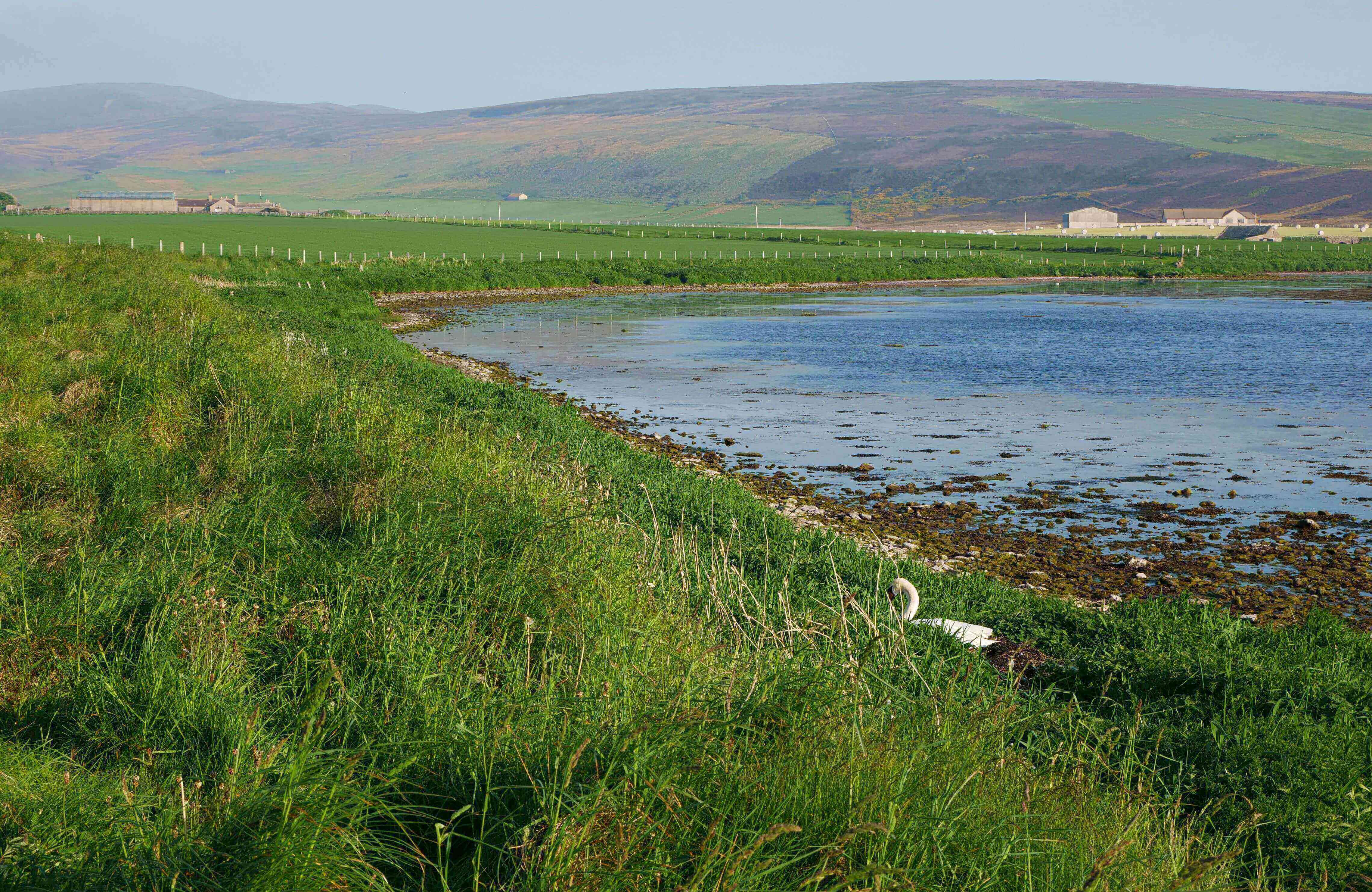
Plant remains found in the bottom of the ditch show that this stone circle was built in open grassland, and we have evidence of farming nearby.
Aquatic plant remains also show that it contained standing water from the start.
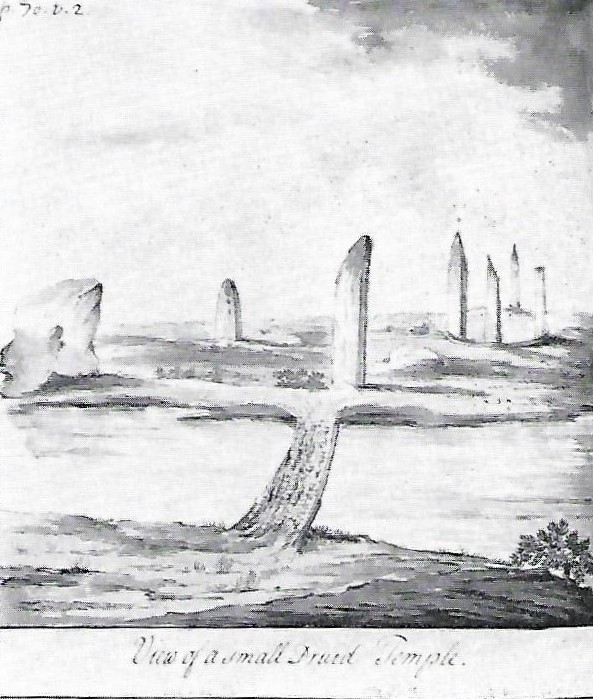 Richard Pococke, 1760
Richard Pococke, 1760The Stones of Stenness circle takes its name from the parish of Stenness, but the parish, in turn, is named after the standing stones.
In Old Norse the place was called ‘Stein-nes’, meaning the headland of the stones. The thin strip of land between the two lochs is the ‘nes’, or headland, in question.
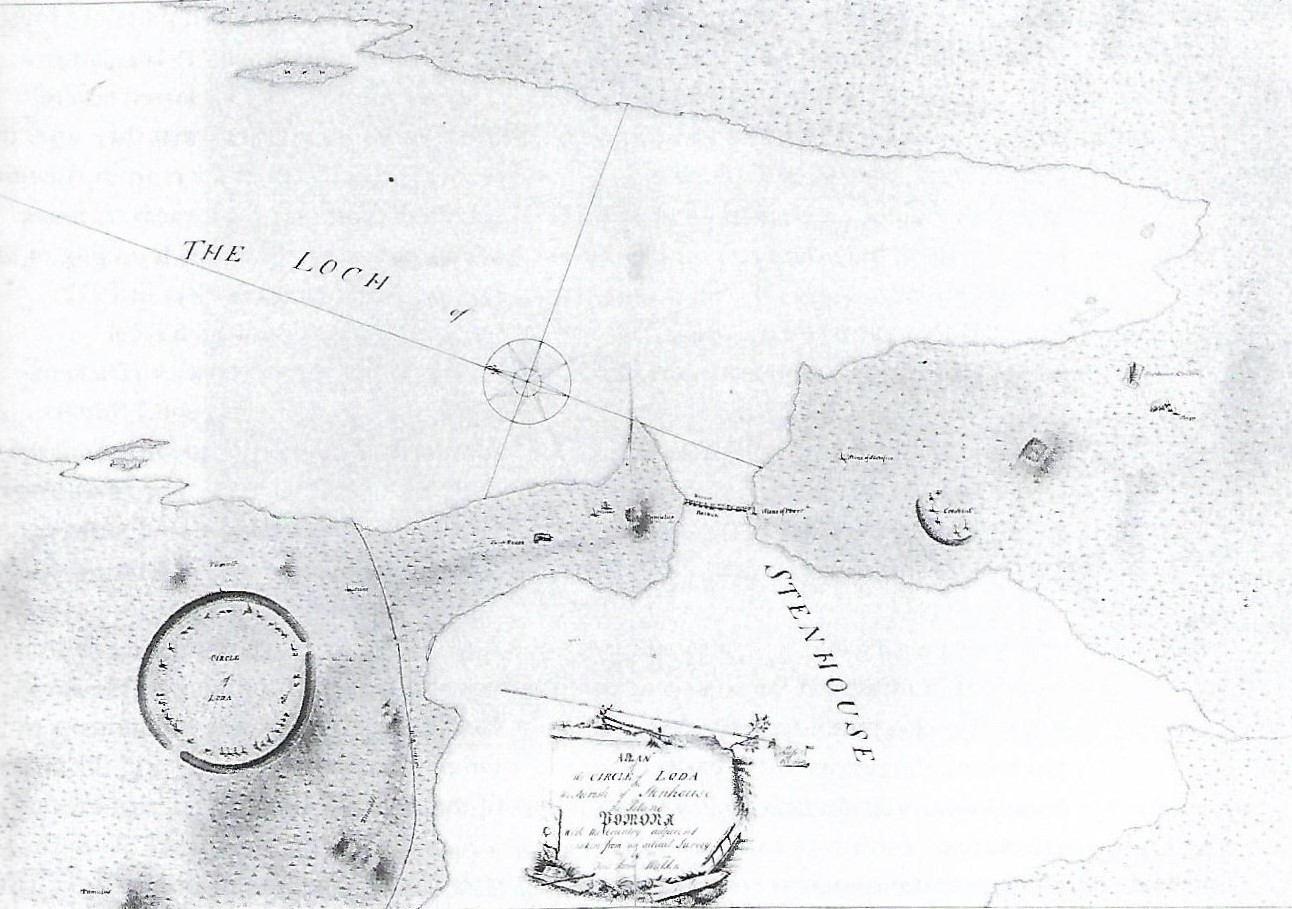 Cleveley, 1772
Cleveley, 1772Fake archaeology news!
The two stones that formed part of the base of the fake dolmen were original and seem to have been set up to frame the tomb of Maeshowe in the distance.
The other pieces of stone used to create the front upright support and top slab of this fake archaeological feature, were pieces of fallen stones. They were re-erected based on an unsubstantiated theory.
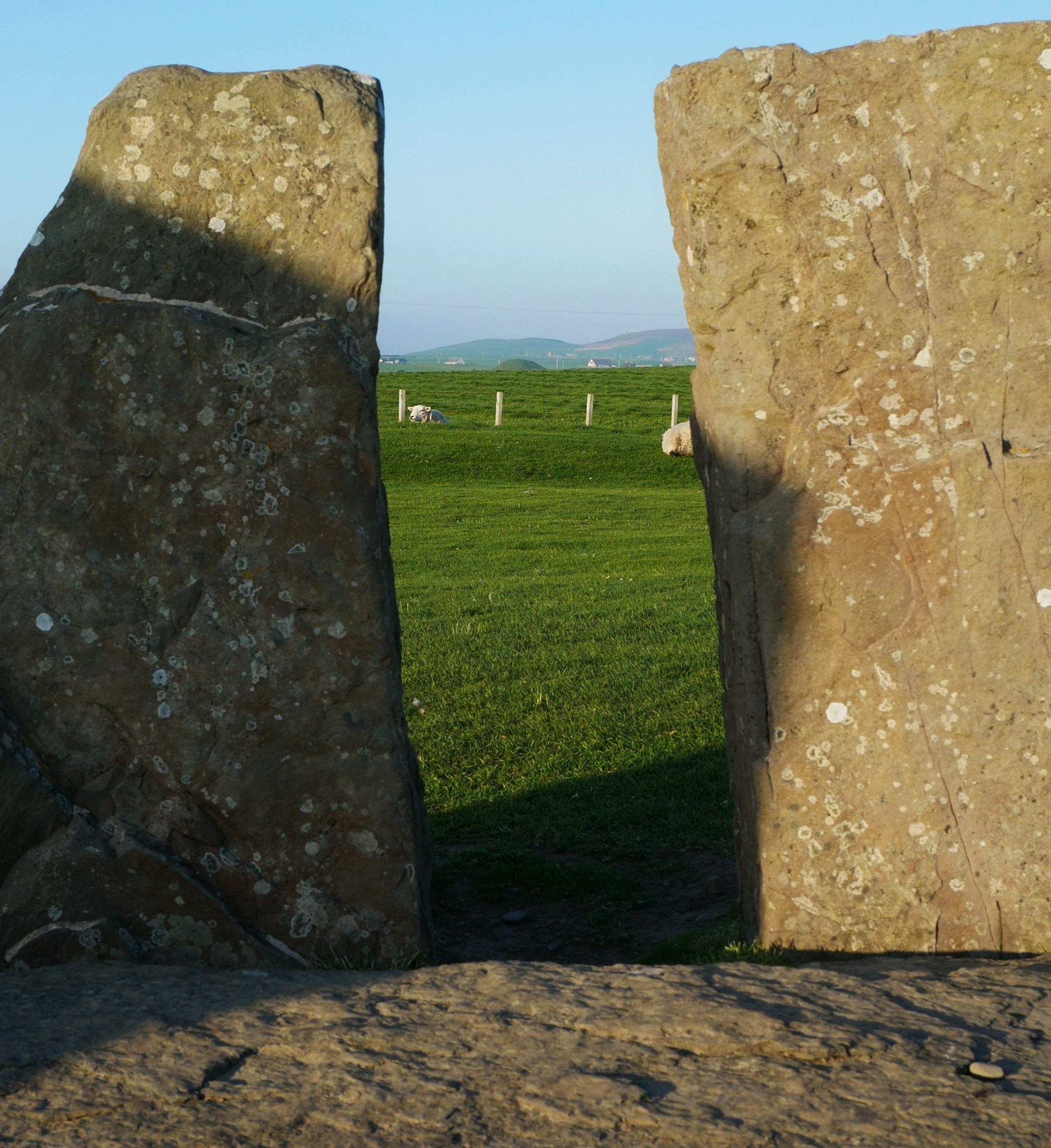
Archaeologists found that the circle had sockets for 11 standing stones. A 12th socket was found to be only be a shallow scoop in the ground, which implies that the stone was never erected.
Geologists have established that the stones come from different sites in Orkney, although many of the stones are missing.
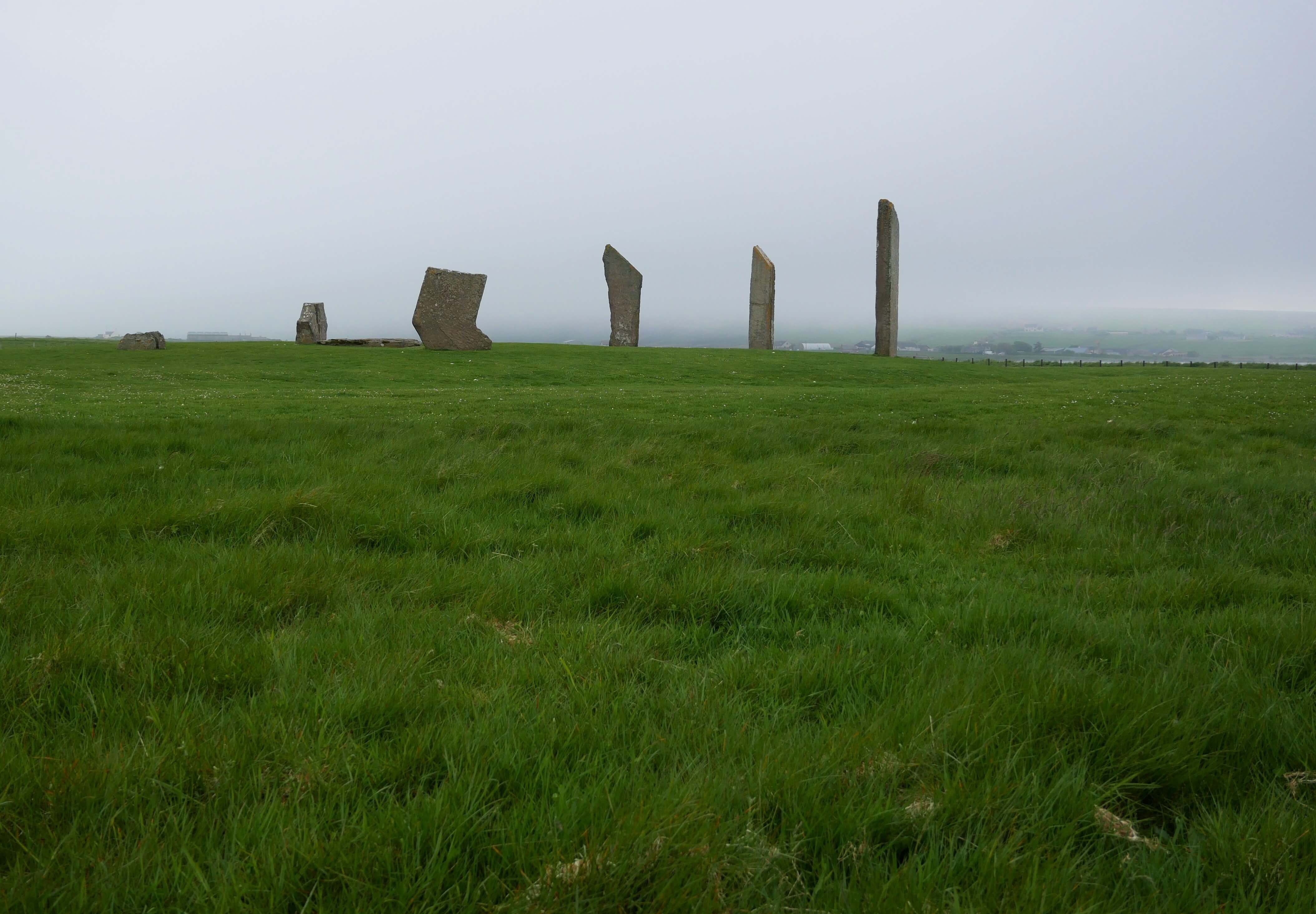
The most unusual and unexpected find of the excavation was the central stone setting, looking like a giant hearth in a Neolithic house.
It seems that burning took place here, as charcoal, burnt bone and broken pottery were found inside the hearth.
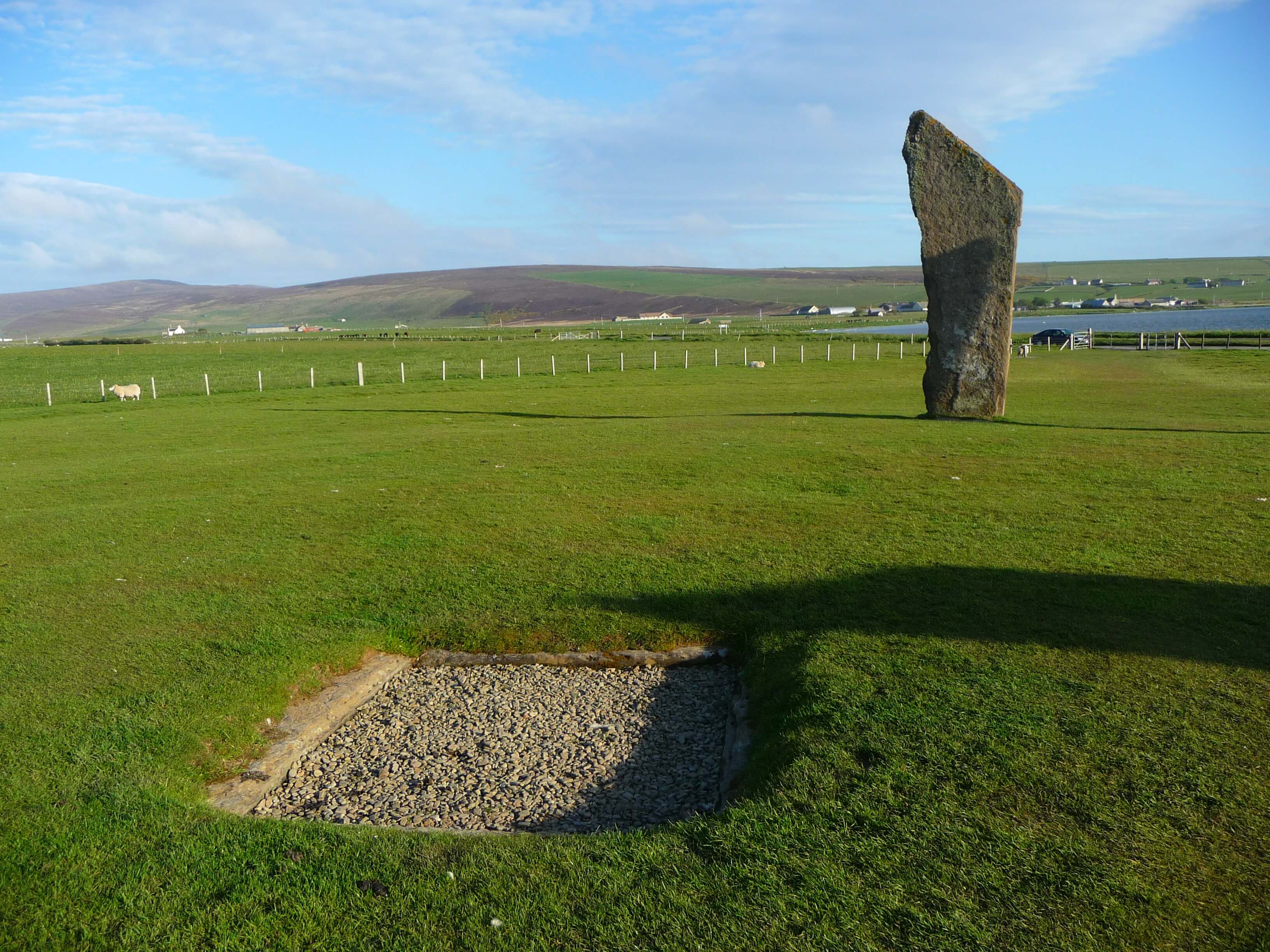
The fill of the ditch contained grooved ware pottery and the bones of sheep and cattle, suggesting that ritual feasting had taken place there.
The bones of large dogs, or possibly wolves, were also found, along with two burnt bones from a human hand.
Whether these bones were ritually deposited in the ditch or simply dumped there is not known, but it seems that everything we find on these ritual sites were placed there for a reason.
I find it hard to believe that the ditch surrounding the Stones of Stenness was casually used as a Neolithic rubbish dump.
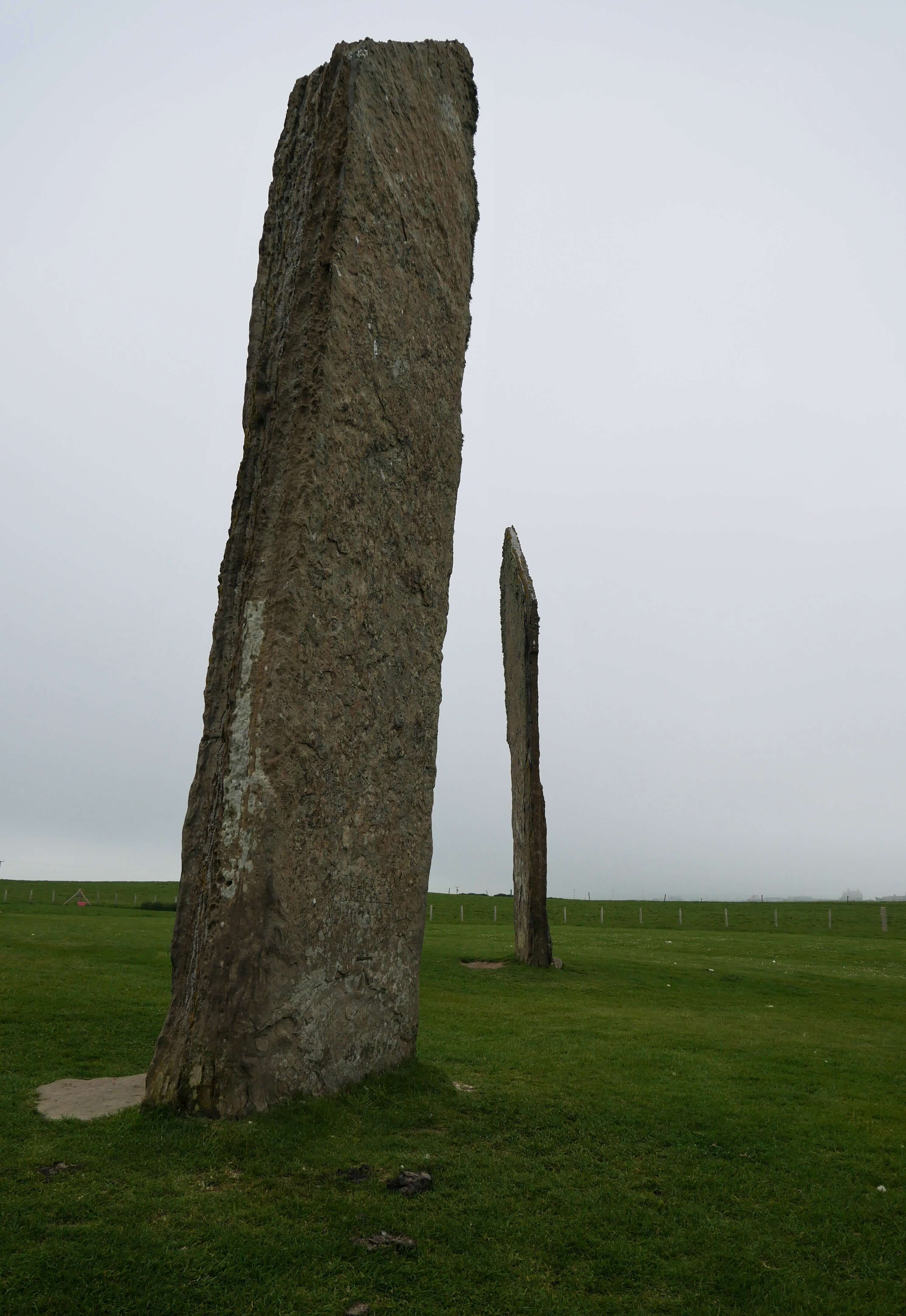
Today the circle is enclosed by a shallow earth bank. This bank dates all the way back to – 1984!
How do I know this? I was one of the people who created it, that’s how.
It was thought that a bank once surrounded the stone circle. The then incarnation of today’s Historic Environment Scotland decided to restore it.
I worked with a small team of archaeologists (three others, plus me) and a team from ‘Ancient Monuments’, who maintained the sites.
We pushed wooden sticks into the ground along the desired route, tied string between them at the right height then brought earth in and sculpted to form the bank that you see today.
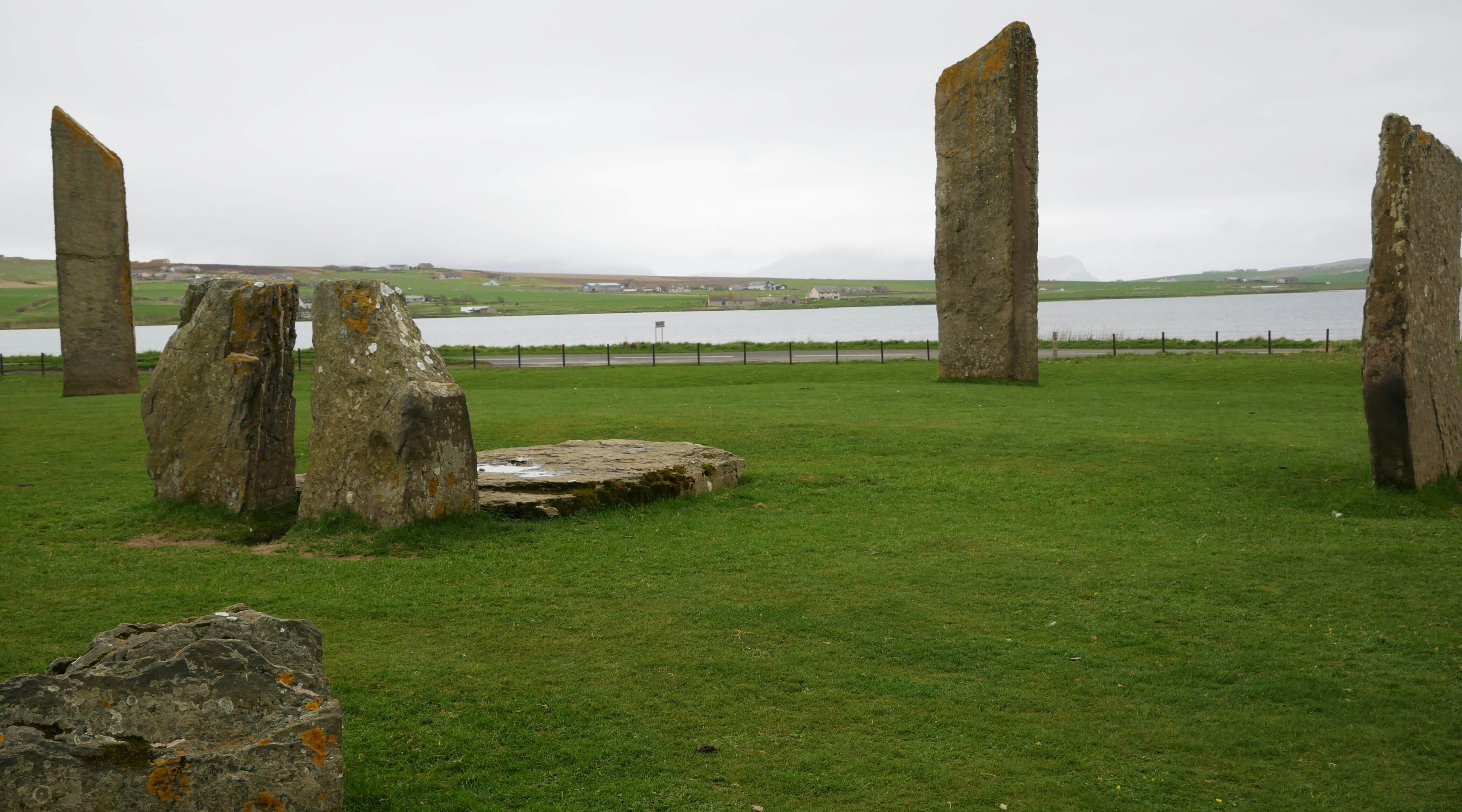
The Pirate
In August 1814 Walter Scott (before he was a ‘Sir’) visited the Stones of Stenness, along with John Rae Snr, the Arctic explorer’s dad. Here Scott met Capt. William Mackay, the tenant farmer who came from Caithness.
Scott admired the stone circle and used the site in his novel ‘The Pirate’.
In his book he has a sacrificial altar within the circle. This bit of creative writing was probably the origin of the later dolman.
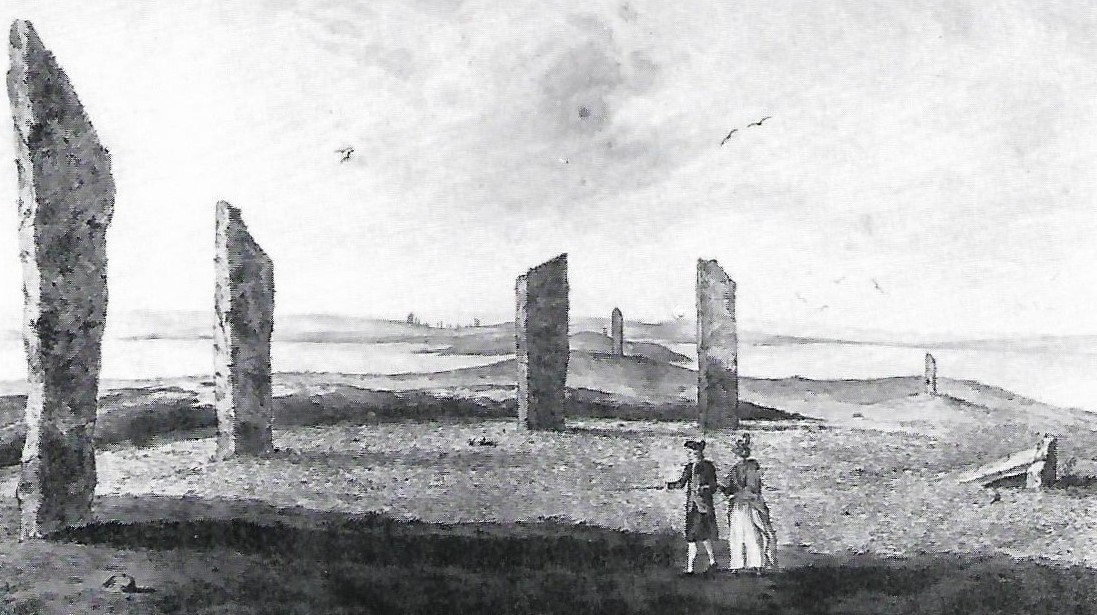 John Cleveley, 1772
John Cleveley, 1772Destruction of the Stones of Stenness
Four months after Scott's visit, the tenant farmer Mackay began destroying the Stones of Stenness. He said that he used the broken pieces of stone as building material for a byre (cow shed).
Mackay would later claim that he was annoyed with people trampling his crops to access the stones.
This is highly unlikely, as the circle stood by the side of the road, which at that time would have been nothing more than a dirt track leading to the bridge.
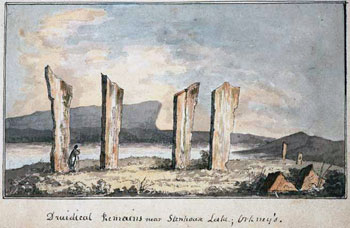 'Druidical Remains'
'Druidical Remains'Mackay was stopped from doing any more damage to the stones by Sherriff Substitute Alexander Peterkin, who was having his Christmas dinner with local historian, Malcolm Laing of Papdale, when the news was brought to them.
Peterkin immediately had a letter written forbidding any more work to be carried out at the site.
By this time, two stones in the circle had been pulled down.
One was broken up with gunpowder that had been packed into holes drilled into the stone. The second lay prostrate, with two holes drilled into it, ready to take the gunpowder meant to destroy it.
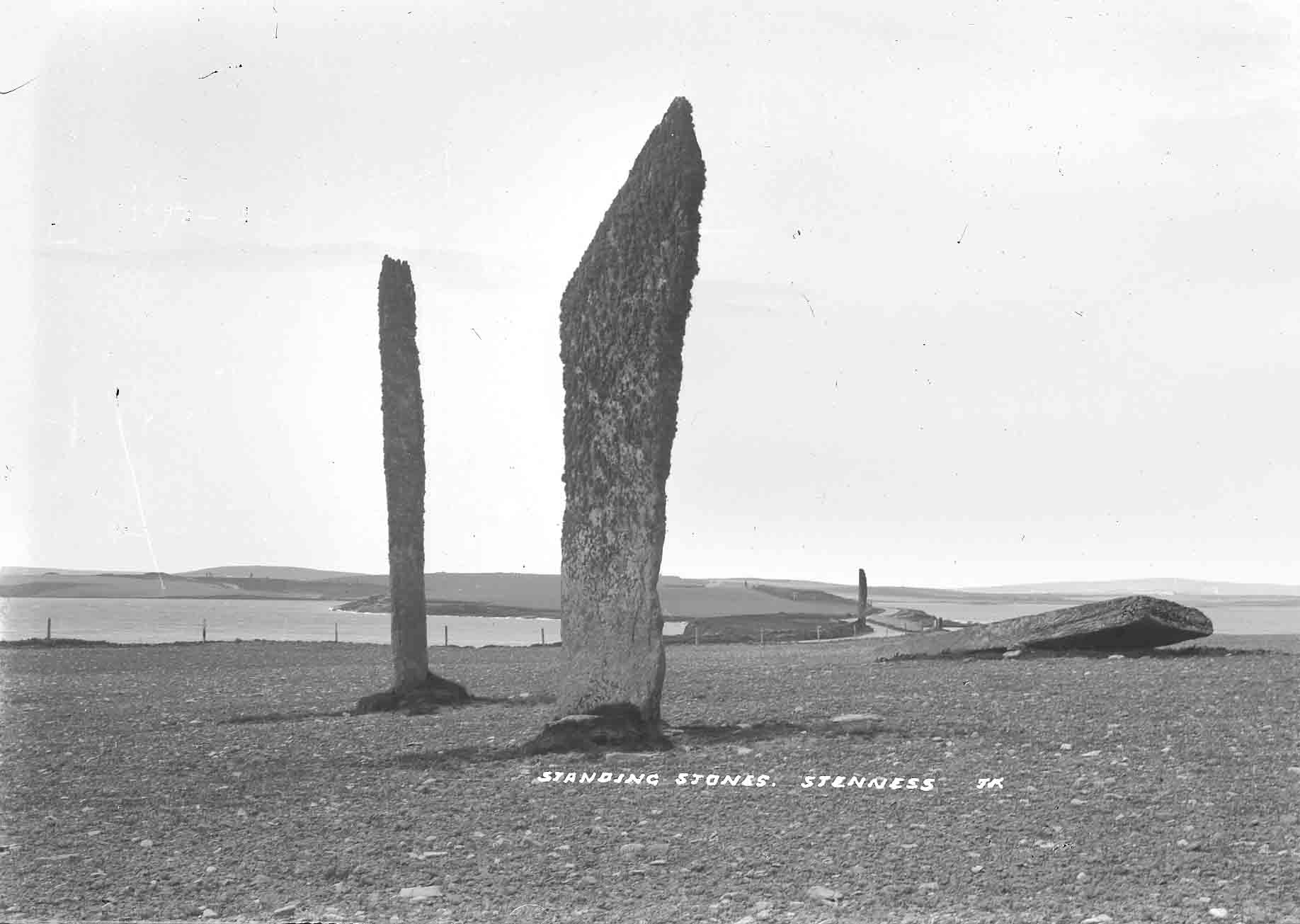 Tom Kent photo courtesy of Orkney Library & Archive
Tom Kent photo courtesy of Orkney Library & ArchiveWhen the rescued standing stone was re-erected in 1907 these small holes were plugged with cement, but you can still see them.
The damaged stone is the one on the left as you stand with your back to the road, facing the circle. You can see the holes diagonally opposite each other at the top and bottom.
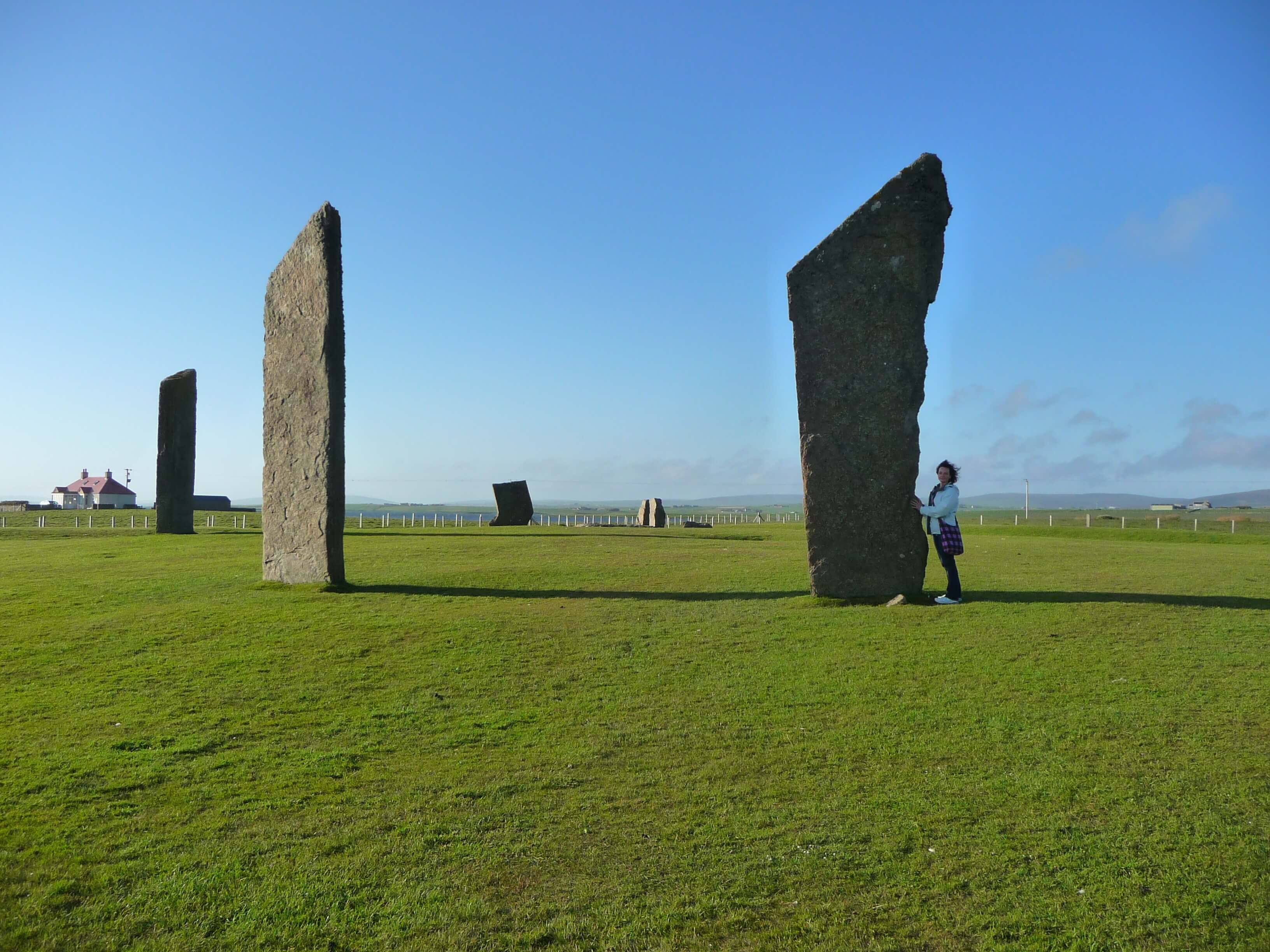
The Temple of the Sun and the Temple of the Moon
There is a 1774 reference by Rev. George Low that refers to the Stones of Stenness as ‘The Temple of the Moon’ and the Ring of Brodgar as ‘The Temple of the Sun’.
Was this a real piece of folk tradition, or just an antiquarian’s flight of fancy?
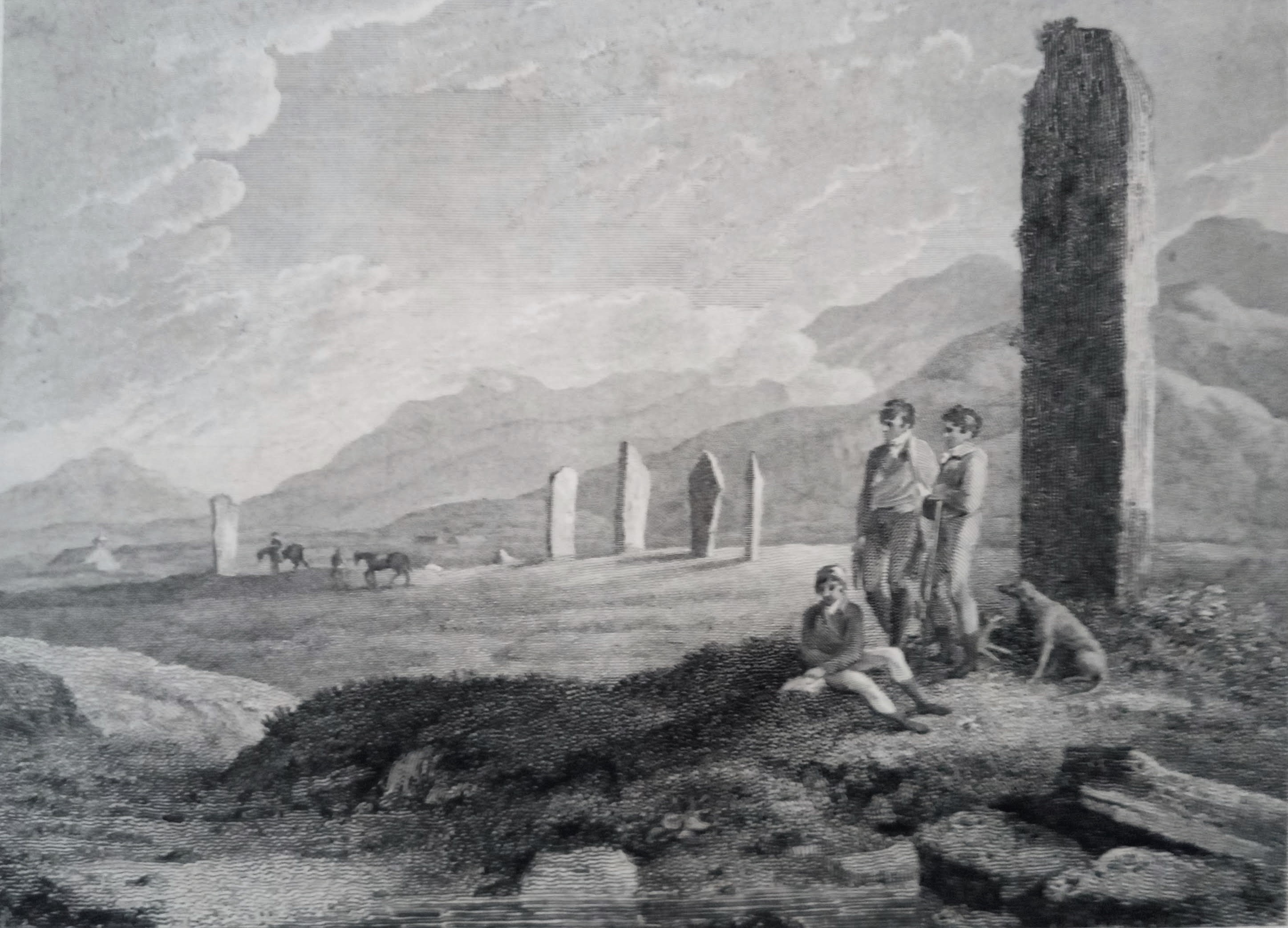
From all my research over the years I cannot find any evidence to back up the his claim. It seems that what Reverand Low was referring to was his own interpretation.
The Stones of Stenness had lost one half of its stones, all at one side, giving the impression of a crescent moon.
The Ring of Brodgar, despite at this time having many fallen stones, was still seen as a complete circle, like the sun.
While local folk viewed the circles with reverence, and indeed, a degree of fear, it seems that the solar and lunar association was not part of our folk belief, no matter how attractive the notion may be to us today.
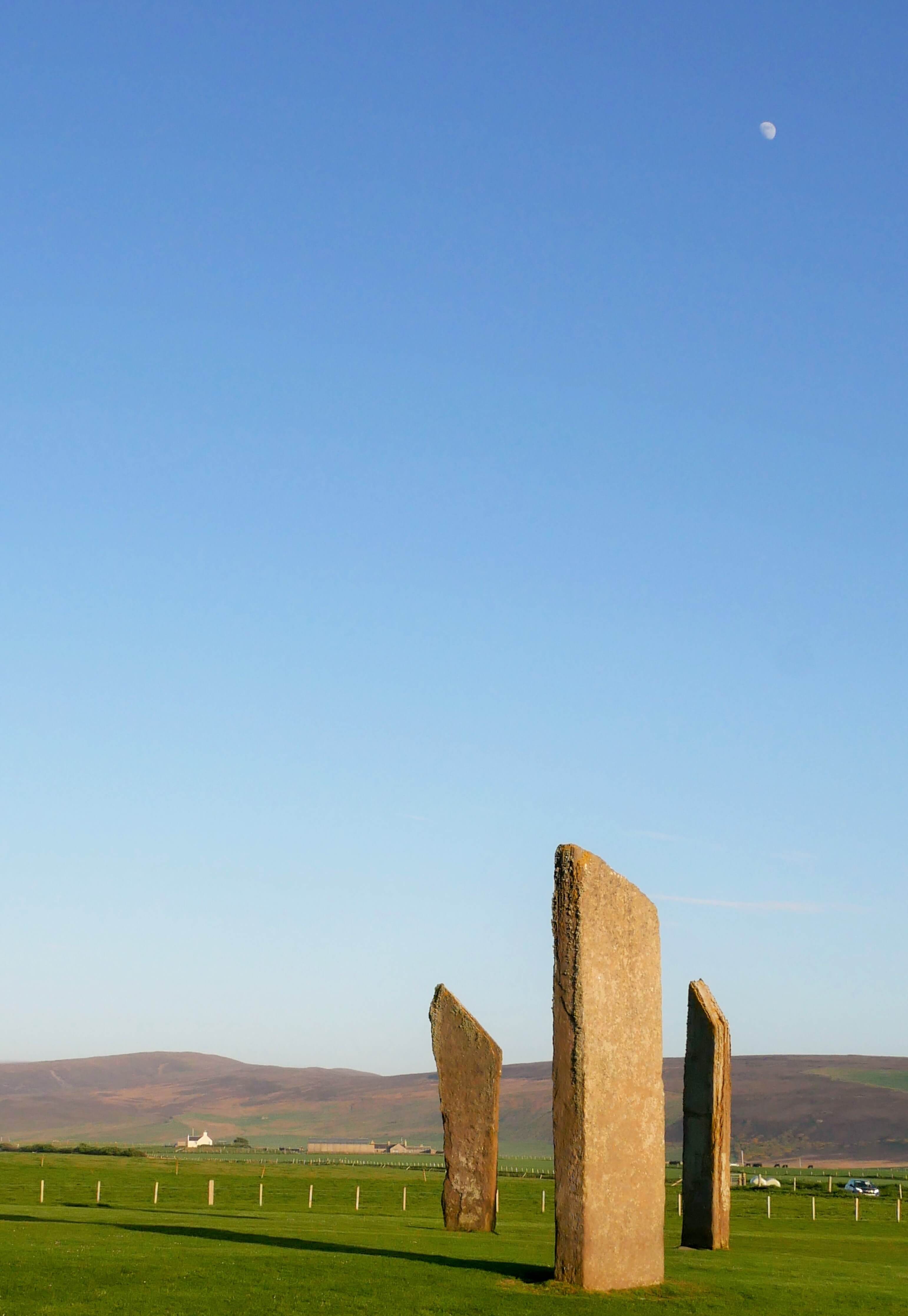
The Watch Stone
The Watch Stone is an outlier of the circle, standing eternal guard at the passageway between the Stones of Stenness and Ring of Brodgar. You'll pass by this solitary giant as you cross the bridge.
It's a large stone - 19 feet high (6.5 meters) - the same size as the stones within the circle.
The name, ‘Watch Stone’ is most likely a corruption of the Old Norse Vatnstein, meaning water/lake stone.
It may have been one of a pair. The stump of a second stone was found in 1930, some 42 feet away, by the side of the loch. It was not aligned with the orientation of the Watch Stone but stood at an oblique angle.
The stump has been removed, so you can't see it today.
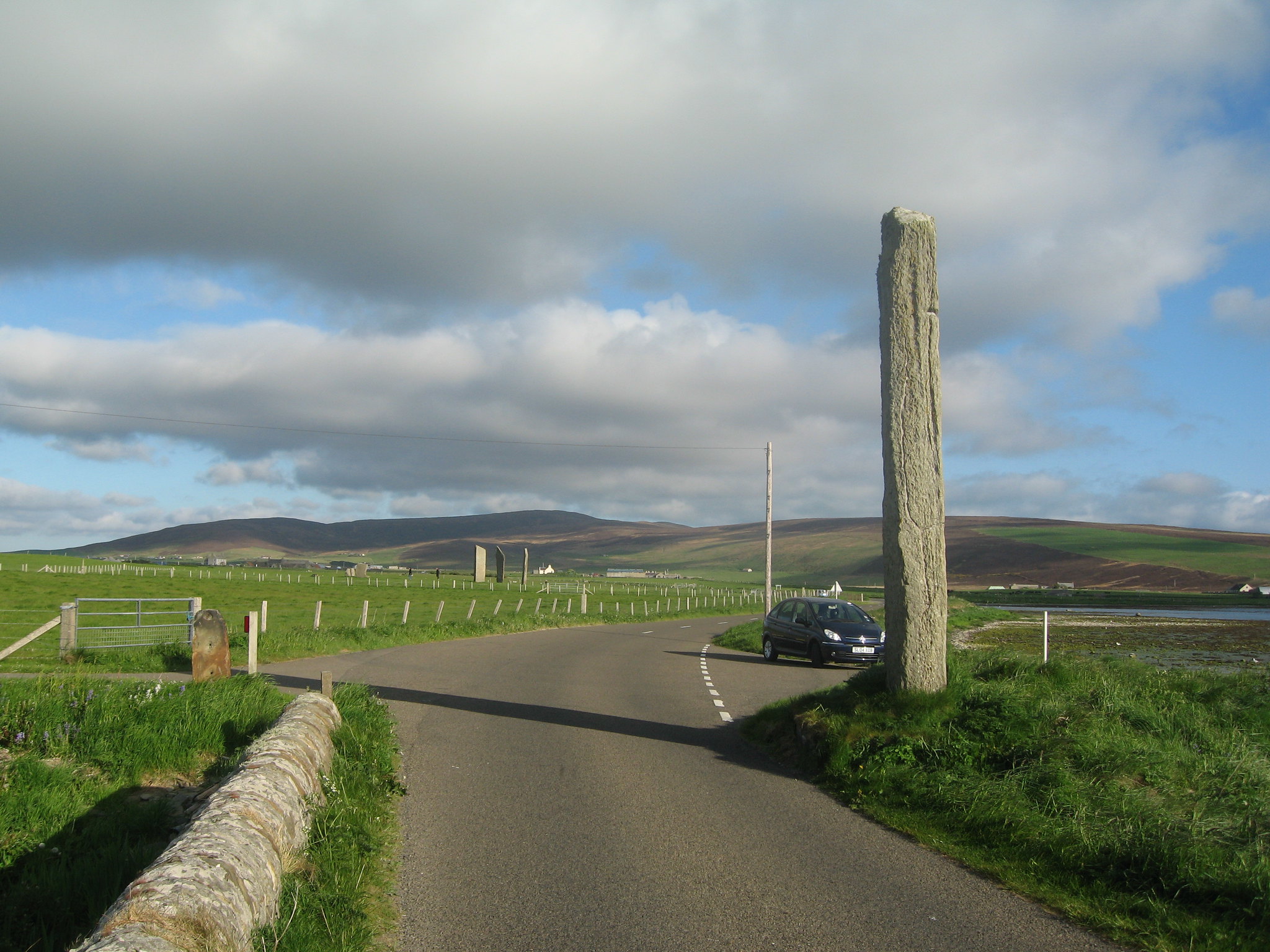
Party stones
The Watch Stone is one of three standing stones in Orkney that go for a drink at Hogmanay - New Year’s Eve.
Legend has it that the stone leaves its position at the stroke of midnight. It dips its head into the Stenness Loch for a New Year’s dram before returning to its rightful place.
It is said that if you try to watch the stone drinking then something will happen to prevent you from getting there on time.
One man who had moved to Orkney heard this tale from a local man and said that he would go and watch the stone have its drink that Hogmanay. When they next met the local man asked him if he had seen the stone drink.
“Oh, no, something happened and I didn’t make it.”
“Ah!” said the local man. “The magic is still working."
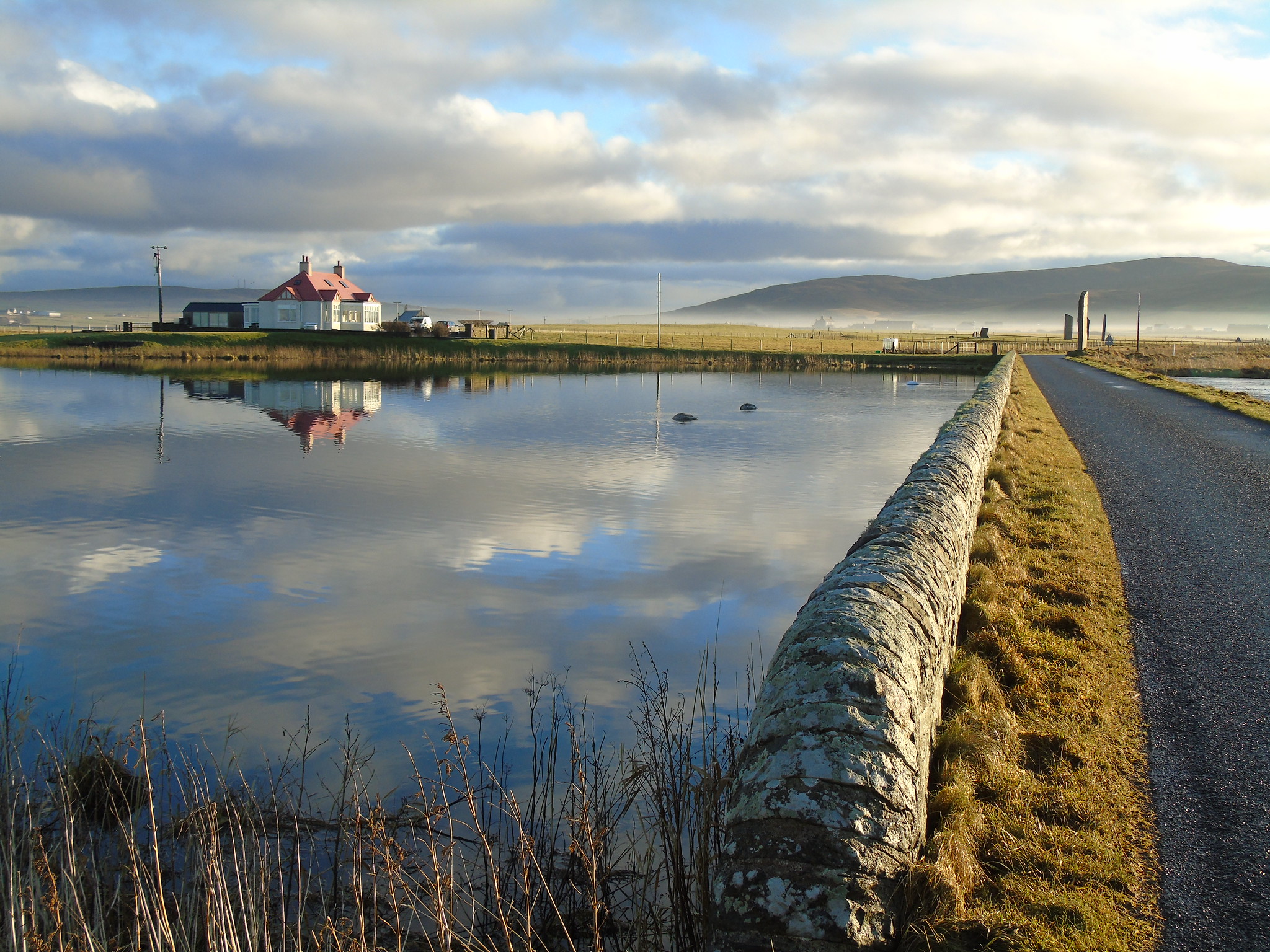
The Odin Stone
Mackay also destroyed the Stone of Odin, another outlier of the circle. It once stood in the field between the circle and Odin Cottage – the house with the red roof.
The man was not well liked anyway, but his destruction of a stone that had so much importance in Orkney lore infuriated the locals.
It's said that they tried to burn his house.
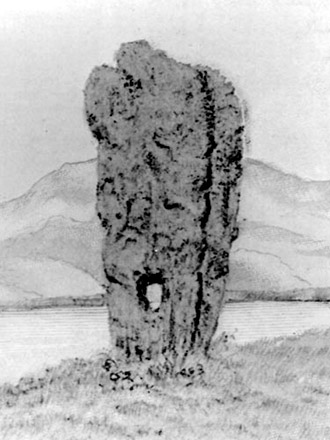 Lady Stafford, 1805
Lady Stafford, 1805The Odin Stone was very important to local folk. It had a hole through which you could pass a baby to prevent it from ‘shaking with the palsy’ (Parkinson’s Disease) in later life.
If you were ill you could pass the affected part of your body, or even your head, through the hole to be cured.
In the story of how the Fin Folk lost Eynhallow, the hero of the tale went around the Odin Stone on his knees - nine times on the night of the full moon for nine months.
On the night of the ninth month he looked through the hole in the stone and was given a vision of how to win the mystical island, invisible to human eyes.
The man was successful in his quest, which is why we can see Eynhallow today.
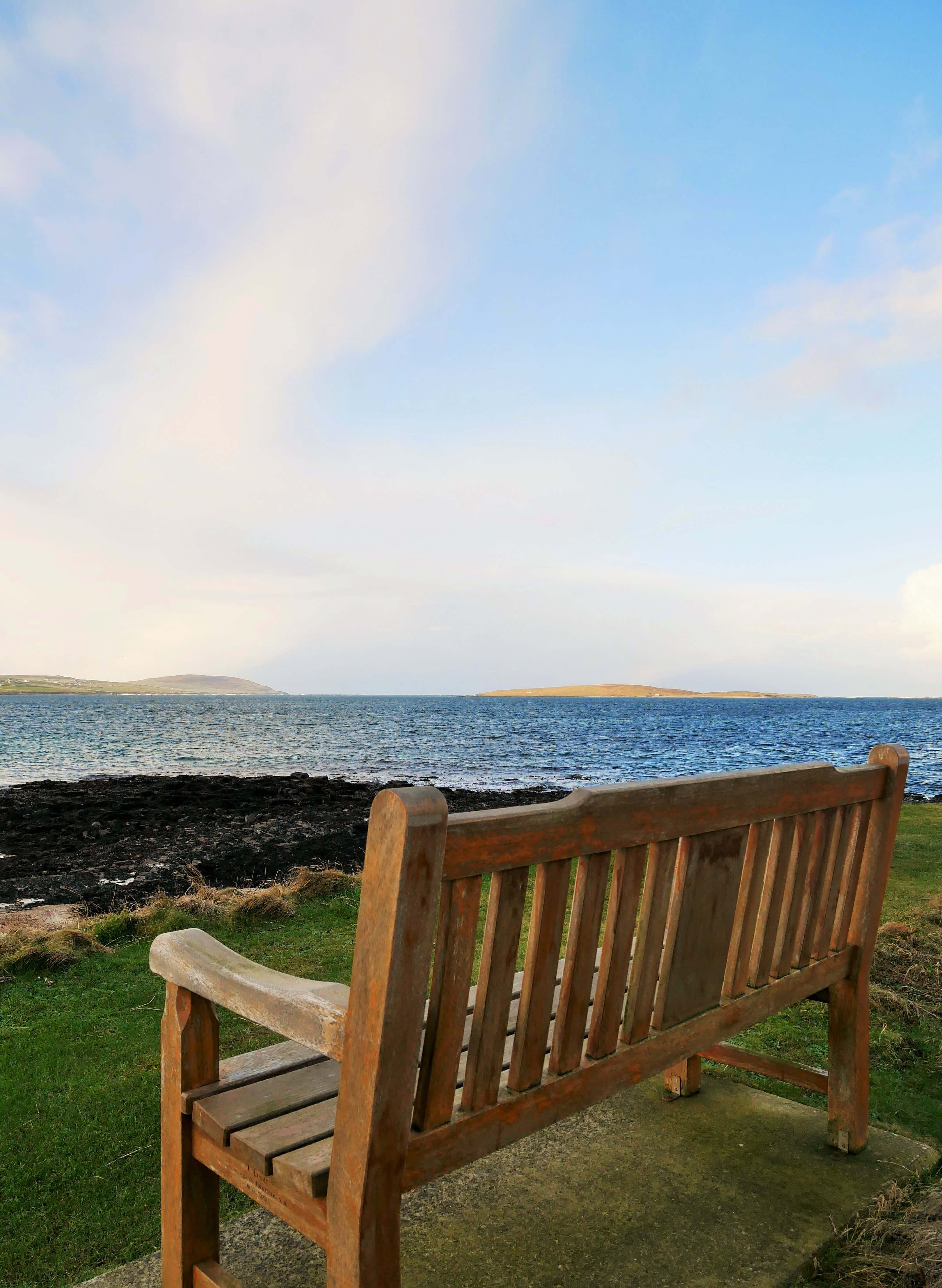
But it was for another reason that the Stone of Odin was famous in Orkney. This wondrous stone was the place where lovers went to plight their troth.
This ceremony was so binding that it could not be broken, unless by further solemn rituals.
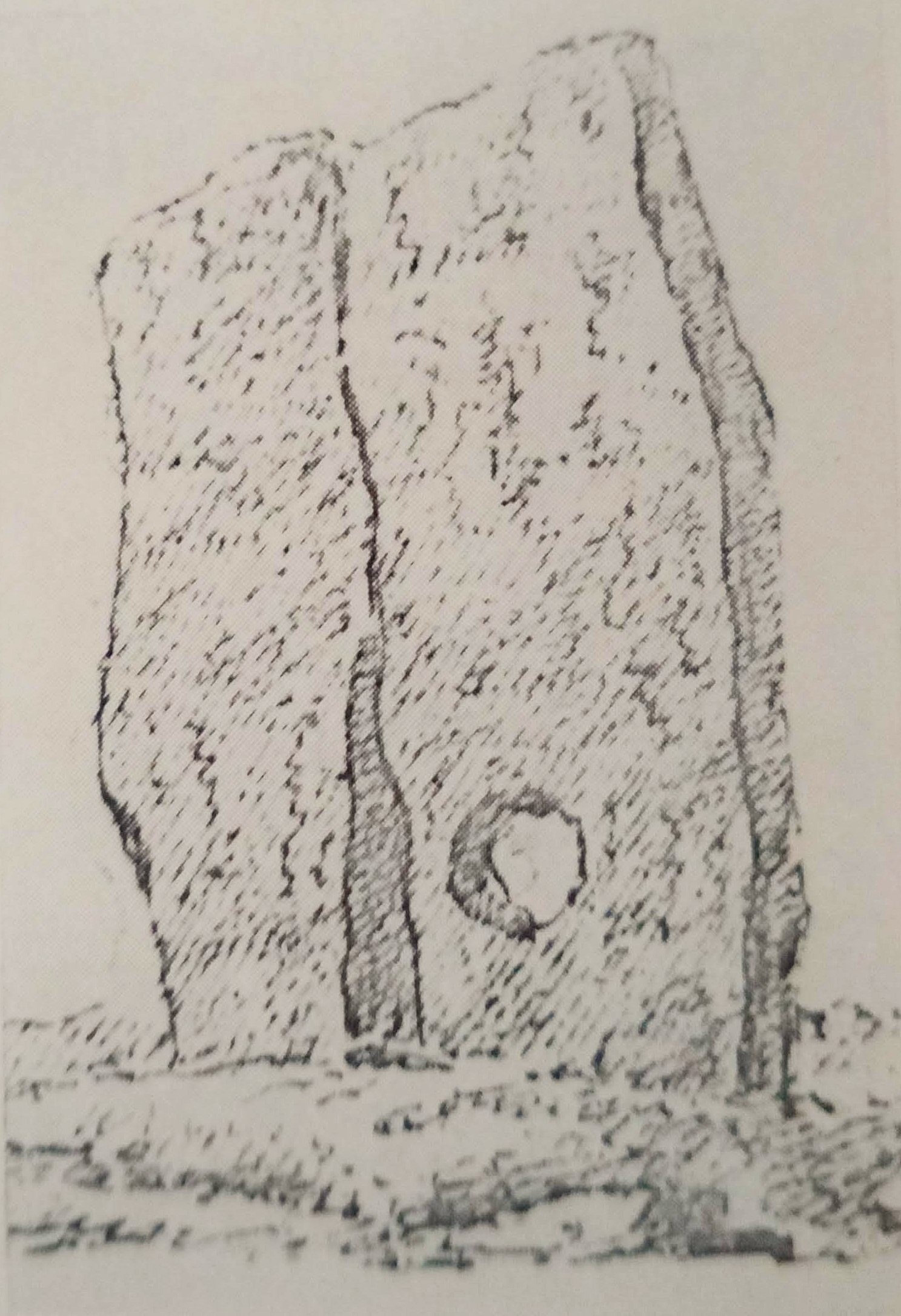 John Thomas Stanley, 1789
John Thomas Stanley, 1789At the new year, young people would gather at the old Stenness Kirk, built in the 12th century, where they would party for four or five days.
Couples would slip away during that time and go to the Stones of Stenness, where the woman would pray to Odin. Then they would go to the Ring of Brodgar, where the man would pray.
Finally they went to the Odin Stone, held hands through the hole and swore the Odin Oath, the words of which are now lost in the mists of time.
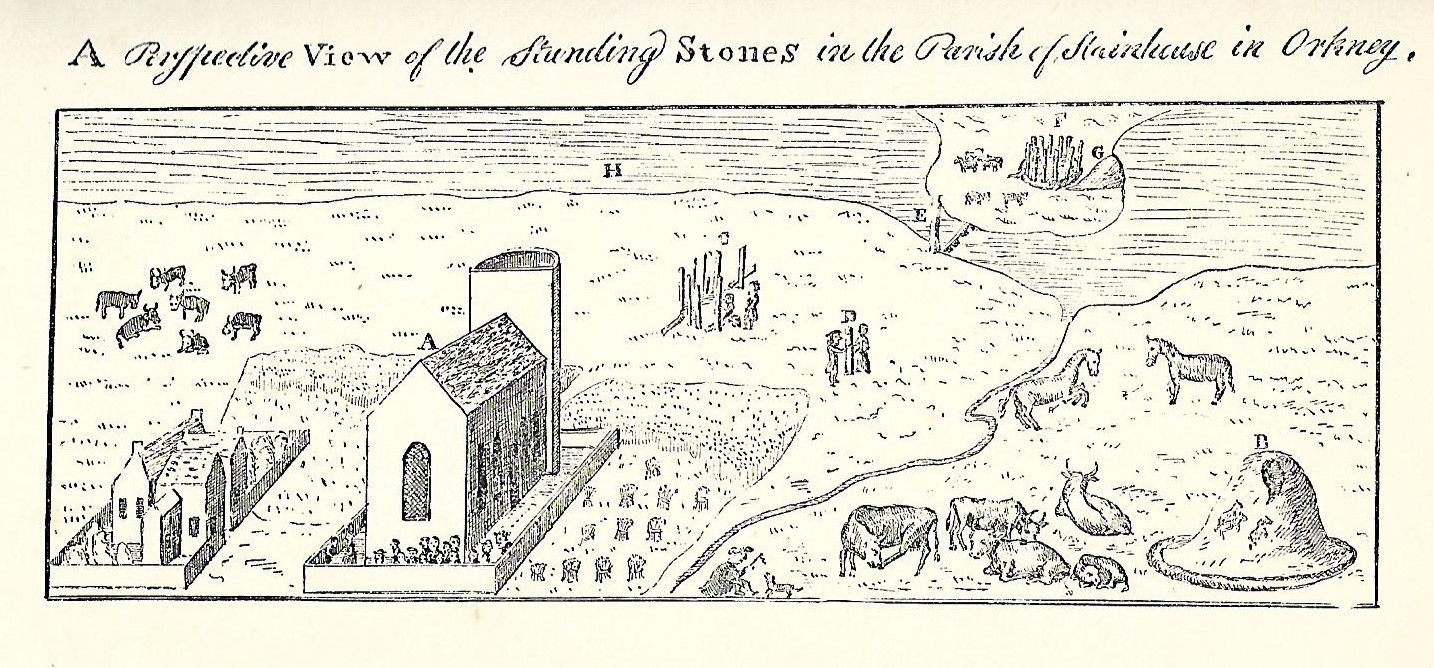 From George Low's Tour Through the Islands of Orkney and Shetland, 1879
From George Low's Tour Through the Islands of Orkney and Shetland, 1879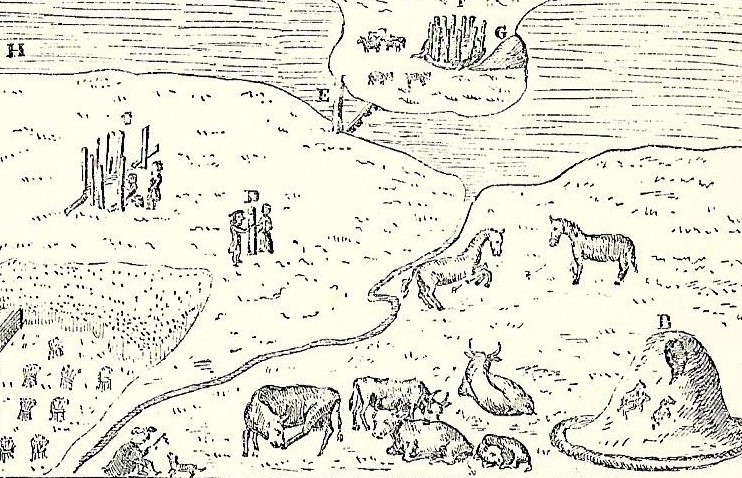 Notice the couple holding hands through the stone?
Notice the couple holding hands through the stone?Taking this most sacred oath mean that the couple could never marry anyone else. There was only one escape clause.
If the couple wanted to break the oath, they had to stand back-to-back in front of the pulpit in the old Stenness Kirk and walk out of the two doors opposite each other, north and south, without looking back.
If one of the couple died, the other had to hold the dead hand that she'd held in life and renounce the oath. If, however, there was no body - if your lover was lost at sea, for example - then you were never able to marry anyone else.
The Odin oath held firm.
Hear the tale of John Gow the Pirate and the Odin Stone
A great loss
The Odin Stone was about 8 feet high (2.5 meters) and 3 ½ feet (1 meter) across, with the hole slightly offset to one side.
The socket for it was found in 1988, along with the socket of another stone. Like the Watch Stone, the Odin Stone was one of a pair.
There was a suggestion to re-erect a copy of the Odin Stone as a Millennium project, but this met with objections and never happened. Some thought that a copy would devalue the original stones standing nearby.
Personally, I thought that a highly carved stone with an inscription saying that it was not the original would have done something to restore the great loss of this hugely important piece of Orkney’s archaeology and folklore.
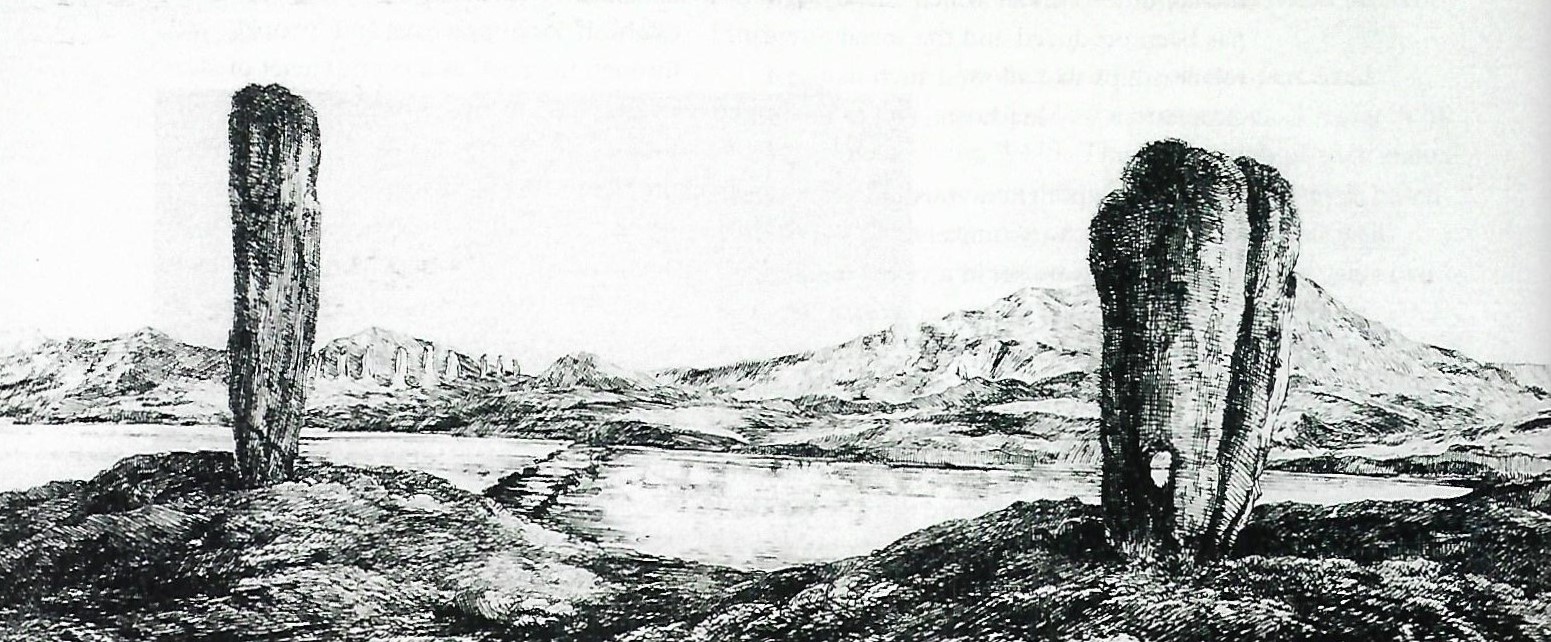 Elizabeth, Marchioness of Stafford, 1805
Elizabeth, Marchioness of Stafford, 1805The Barnhouse Stone
In a field about half a mile to the south-east of the Stones of Stenness stands the Barnhouse Stone.
This single stone is easy to recognize. It has a barbed wire fence around it to protect it from itchy cows.
Before the fence was erected, cows found this rough stone a perfect itching post. People worried that this could eventually loosen the stone and cause it to fall.
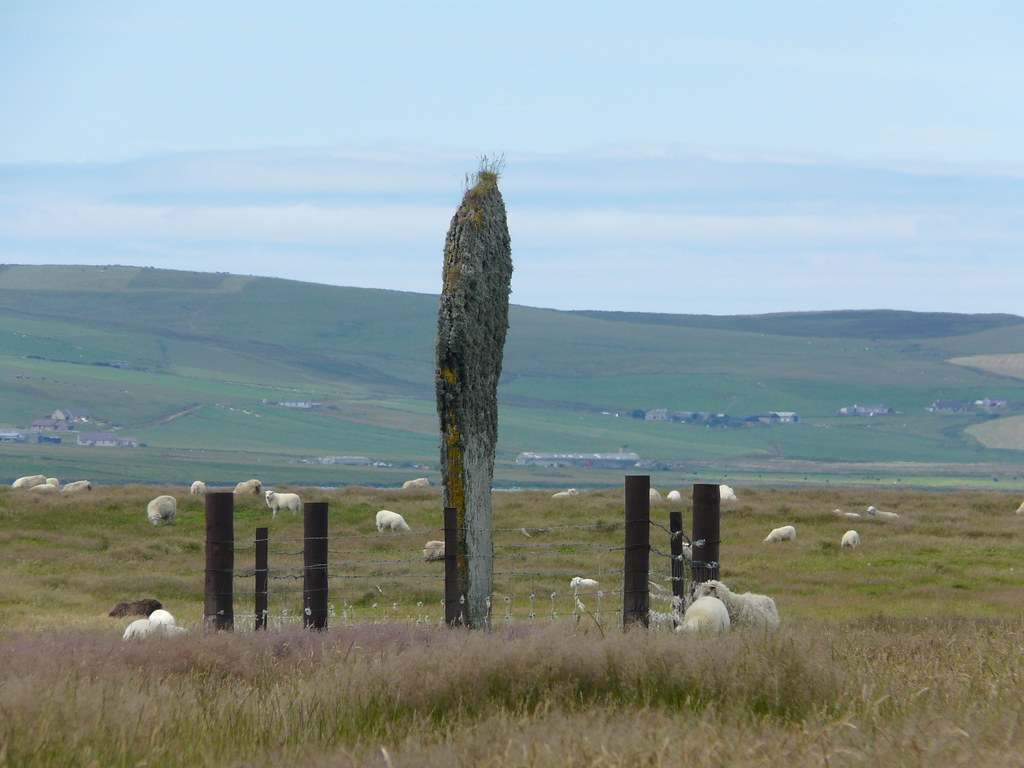
The name ‘Barnhouse’ is from the farm's name where the stone stands – the same as the nearby settlement of Barnhouse.
The name has nothing to do with barns. This is another Old Norse place-name meaning a prayer house, used in the early days of Christianity.
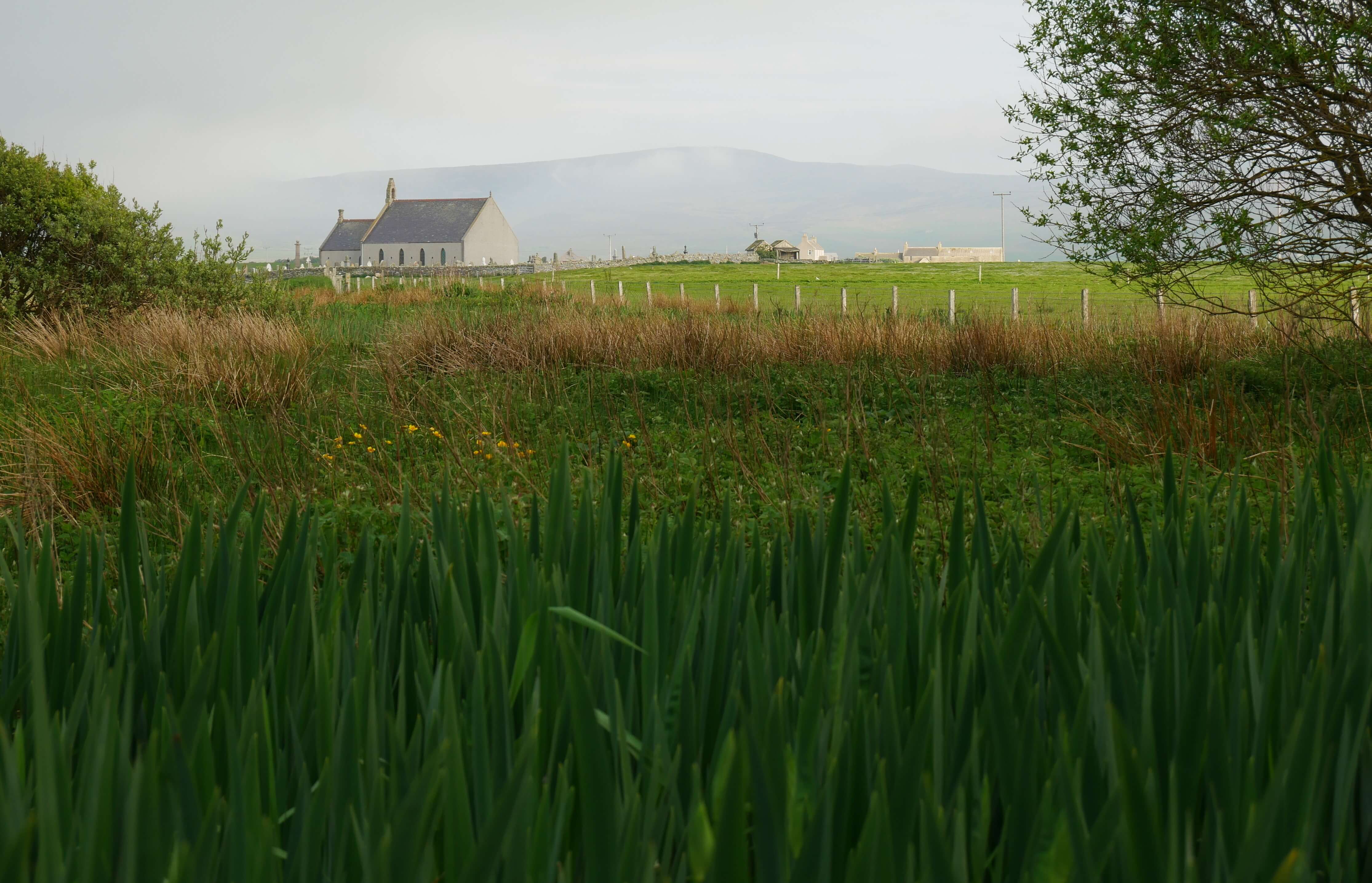
Perfect midwinter alignment
The Barnhouse Stone is perfectly aligned with the entrance to the tomb of Maeshowe and the setting sun at midwinter.
As the sun sets, it sits above the stone while the sun’s rays creep along the passageway into Maeshowe, illuminating the chamber within.
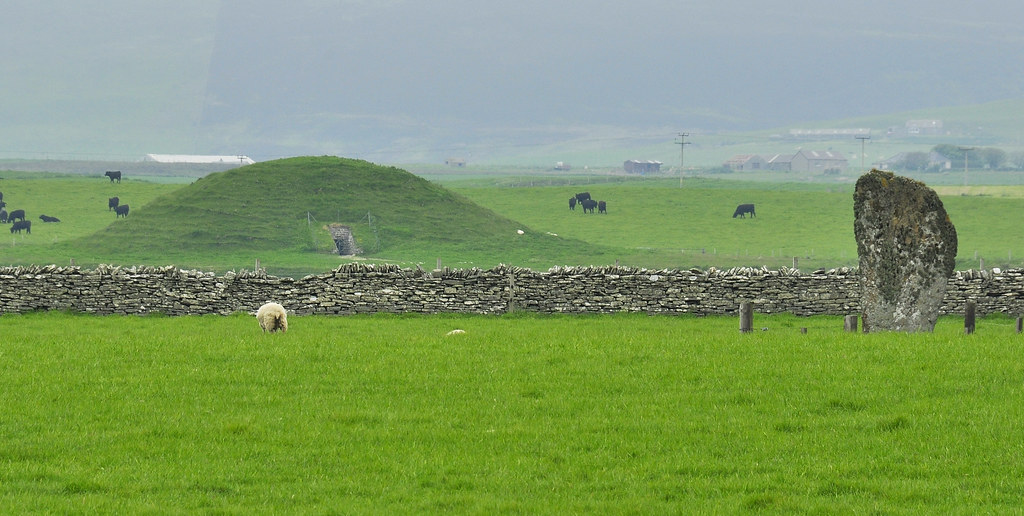
This is no coincidence. Neolithic people used alignments in the landscape when erecting their monuments.
The midwinter sun illuminating the house of the dead must have had strong spiritual significance. Were our Neolithic ancestors taking the sun into the tomb at the time of the year when it was seen to be dying, only for it to be reborn to shine again?
If the Barnhouse Stone is an outlier of the Stones of Stenness, then we have a very strong link between the two sites - the stones and Maeshowe. This is in addition to Maeshowe being framed between the two small stones within the stone circle.
These great Neolithic monuments should never be viewed in isolation but as elements of a greater whole.
Something big was happening here in Neolithic times.
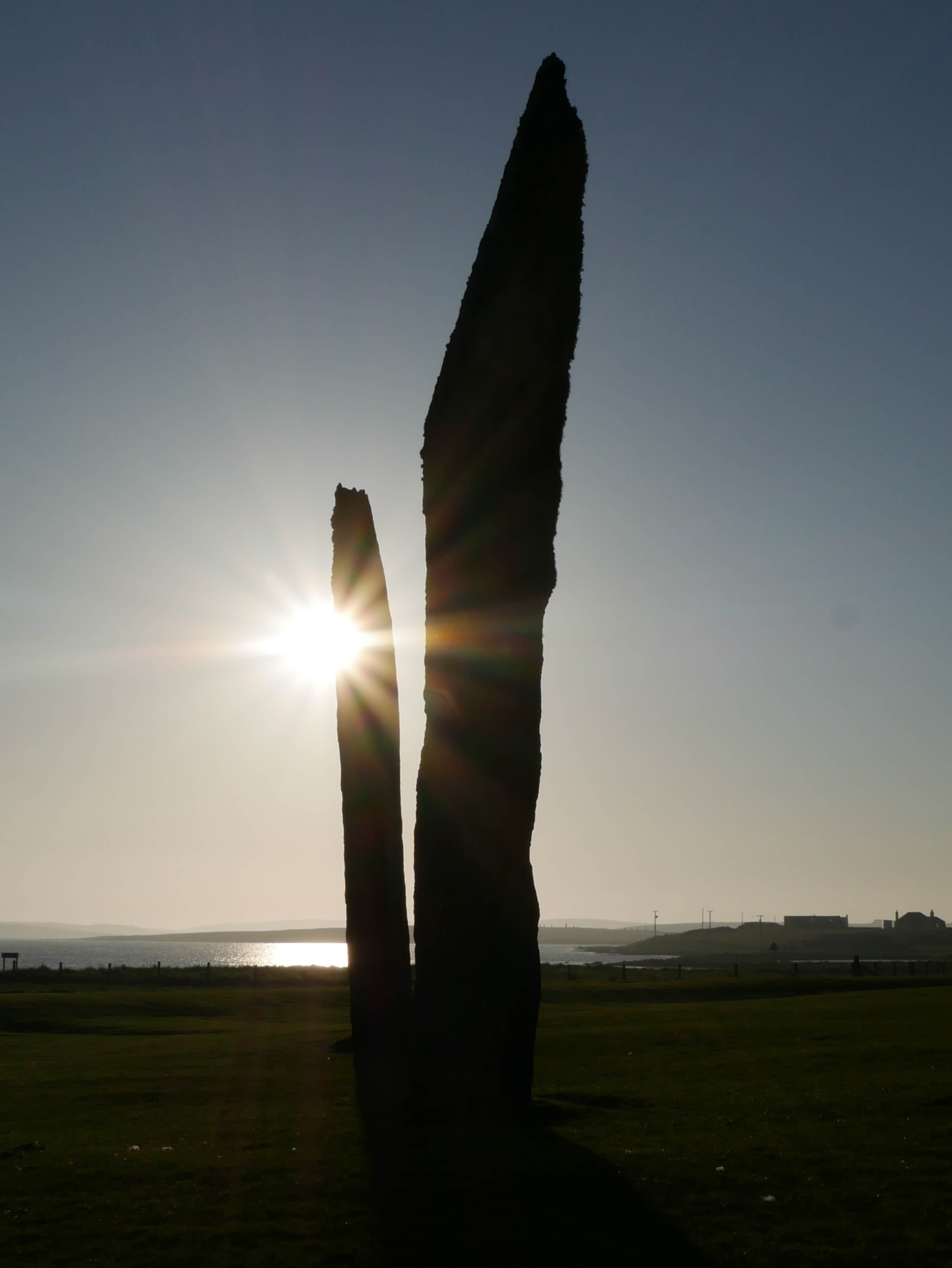
Visiting the Stones of Stenness
You'll see a small car park at the side of the road. Open the gate and wander inside. Please be sure the gate is closed when you leave.
If you bring your dog, keep it on a leash for the comfort of other visitors, as well as the sheep you might find grazing there.
This Stones of Stenness are free to visit and are open year-round.
Free guided tours at the stones and the Barnhouse Neolithic Village just behind the circle run throughout the year, courtesy of Historic Environment Scotland Rangers.
The path to Barnhouse is to the left of the stones. You can access it from the road or through a gate at the rear of the stones' enclosure.
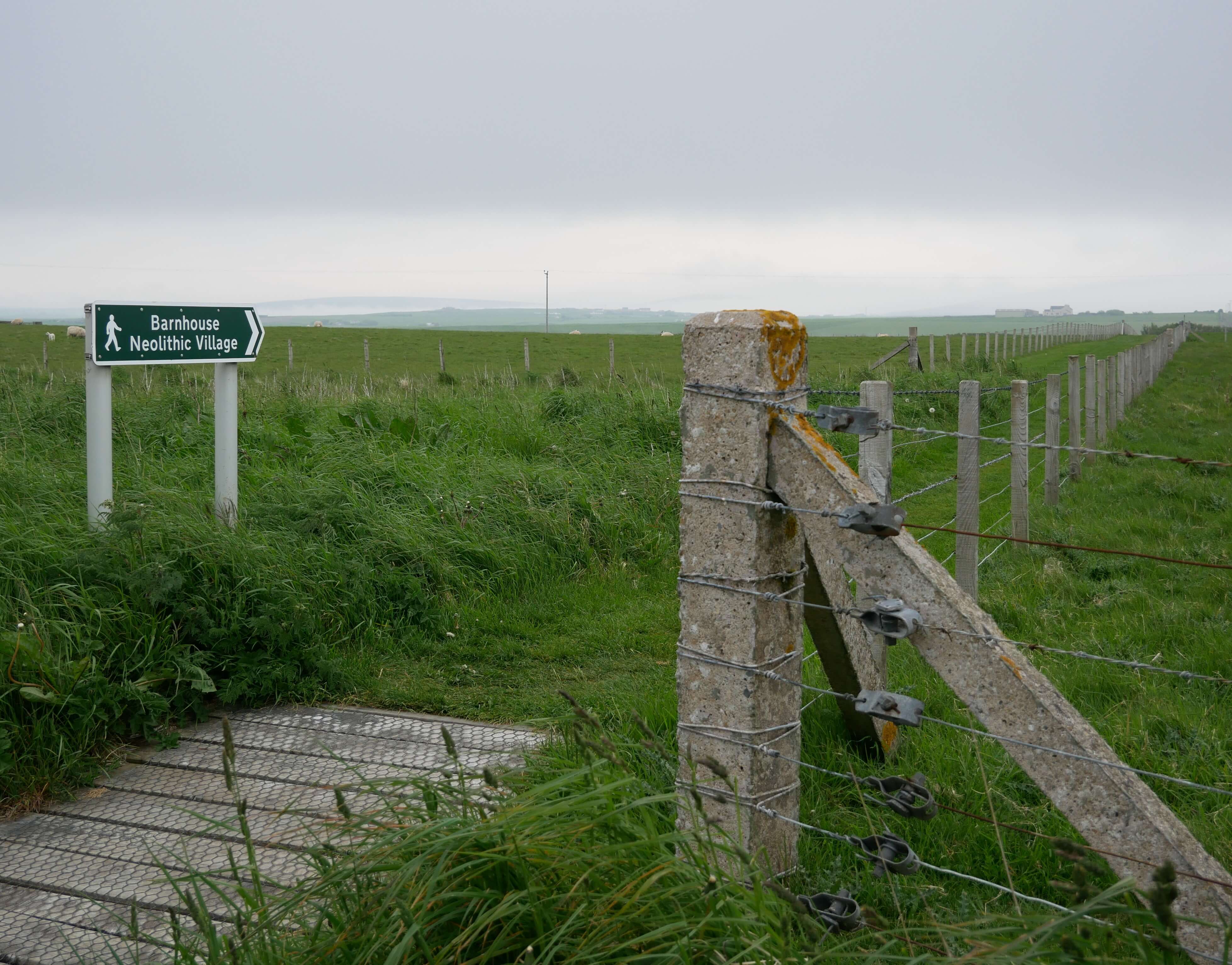
The free ranger tours are available June, July and August: every Monday, Wednesday and Friday at 10am
September through the winter months until May: every Wednesday at 10am
Barnhouse Bird Hide
Behind Barnhouse is a path leading through a thicket towards the Harray Loch, where you're likely to see happy fishermen fishing away in any weather.
Here you'll find a nice bird hide where you can sit, dry and comfortable, and spy on the many birds to be seen around the loch.
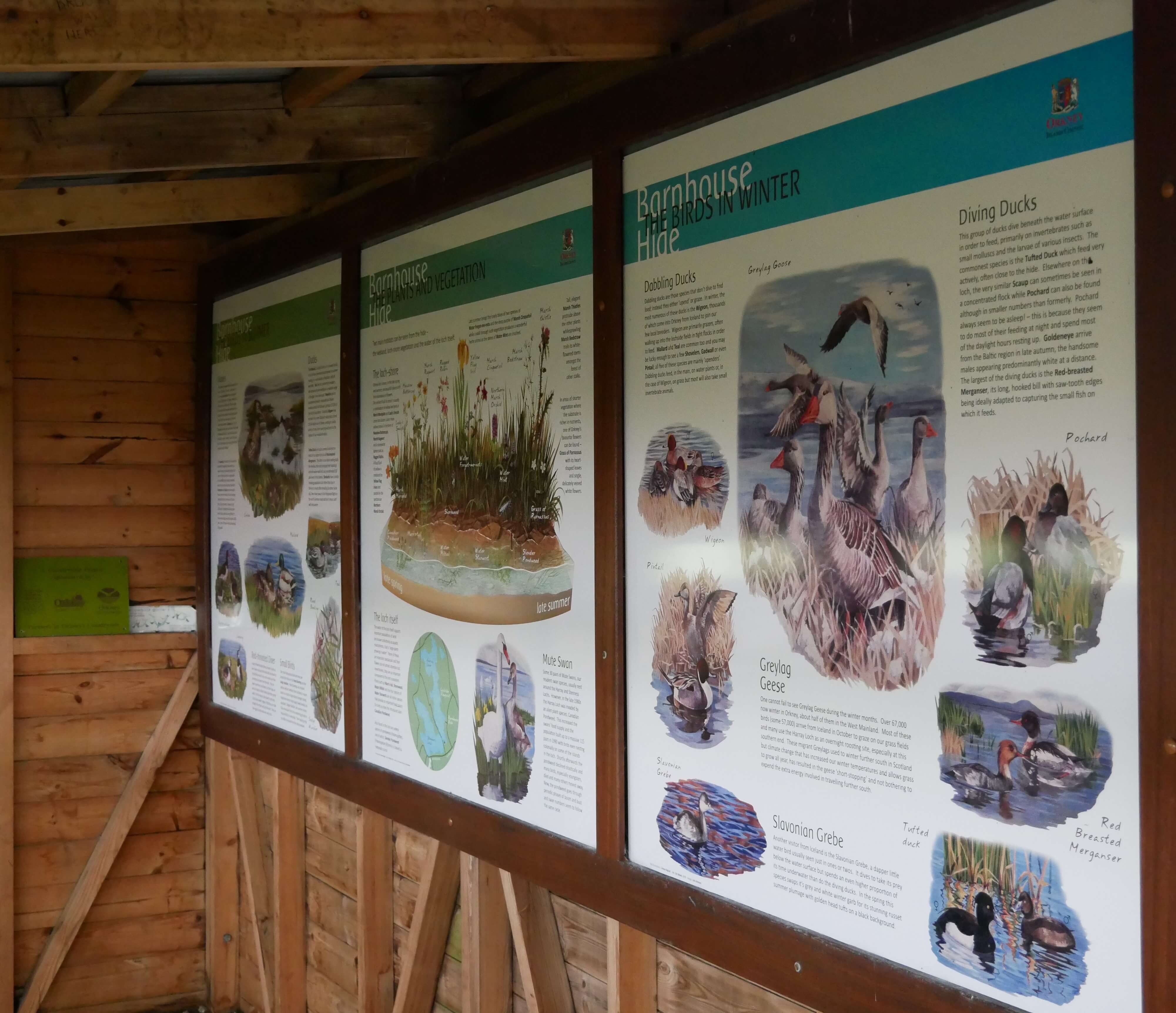
Bird watchers can find more information about birds in the Brodgar area here.
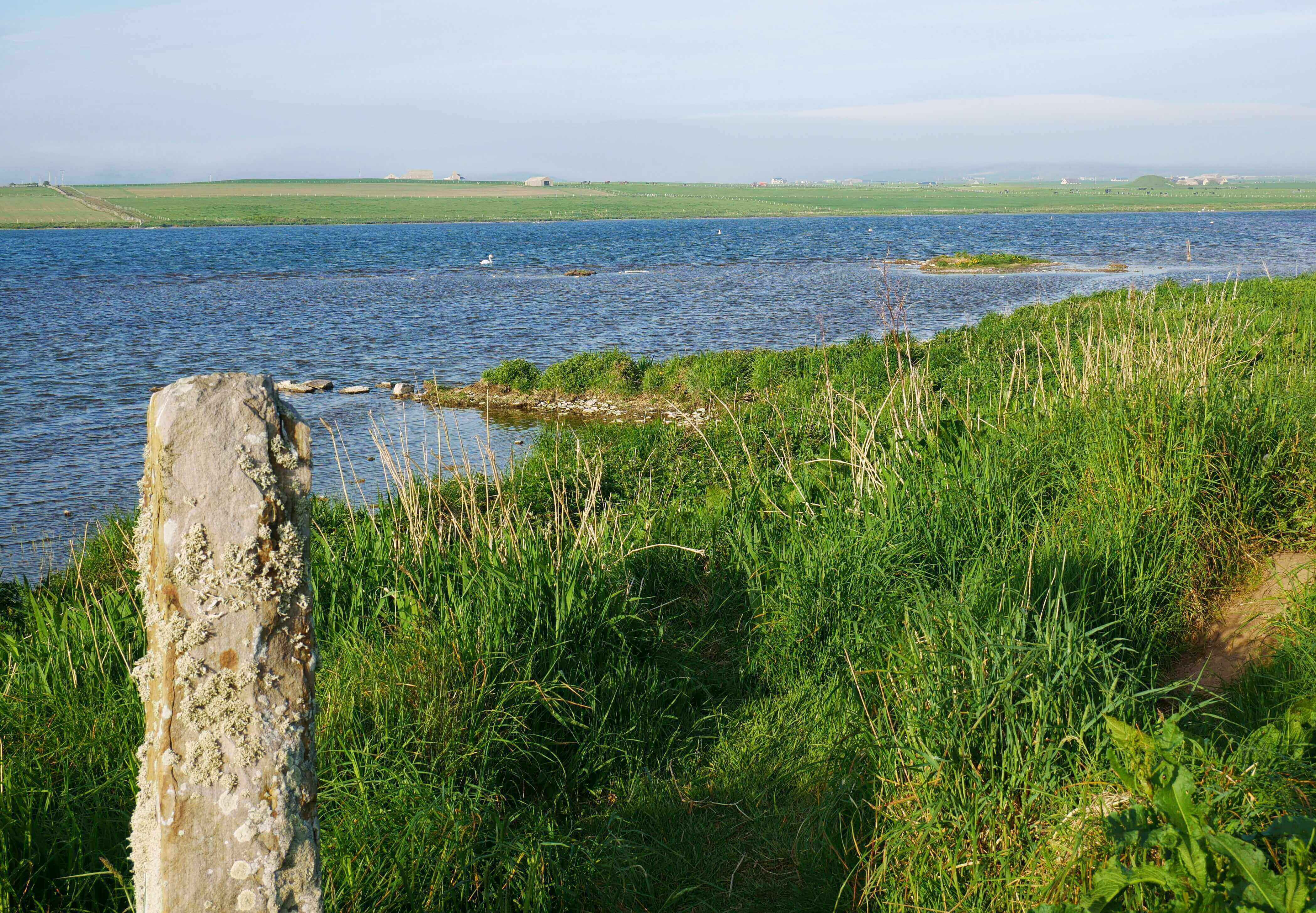
Enjoy a virtual walk around the stones
Enjoy your visit to the stones!

More Orkney must-sees

Mermaid image (Rhonda's pages) and storyteller image (Tom's pages), and all other illustrations except where noted are here by the courtesy of our dear friend - Stromness author, artist and historian, Bryce Wilson MBE, who owns all copyrights. Thanks, Bryce!

